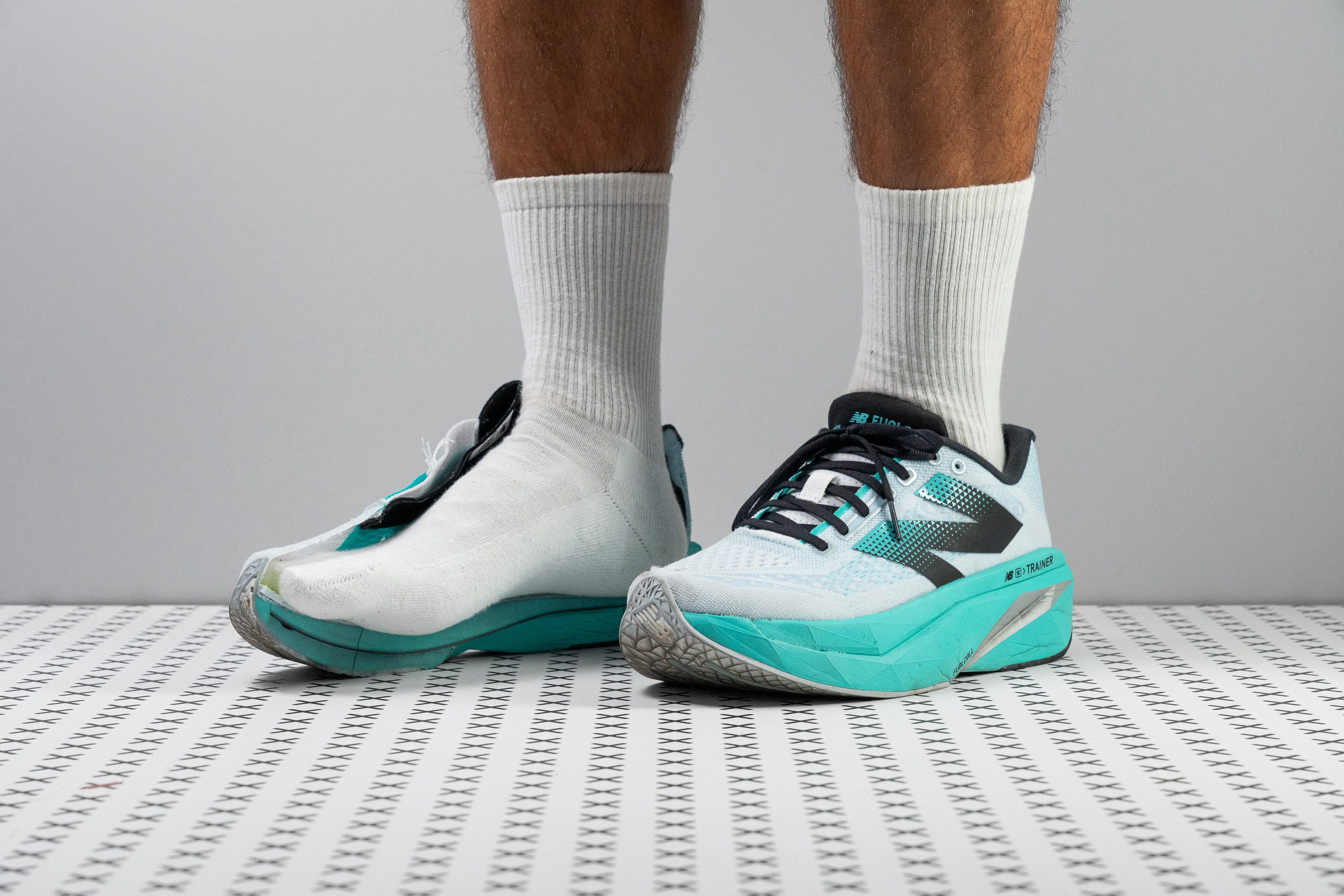Our verdict
- Top pick in best cushioned New Balance running shoes
Pros
- Reasonably priced
- Ultra-soft, responsive midsole
- Includes a carbon plate
- Ideal for marathon training
- Great stability
- Premium upper delivers great fit
- Fantastic for midfoot strikers
- Solid traction
Cons
- Increased weight
- Still not 100% PEBA foam
- Midsole groove traps pebbles
- Upper durability
Audience verdict
- Top 11% most popular running shoes
Comparison
The most similar running shoes compared
+ + Add a shoe | |||||
|---|---|---|---|---|---|
| Audience score | 85 Good! | 92 Superb! | 86 Good! | 89 Great! | |
| Price | $180 | $170 | $225 | $160 | |
| Pace | Tempo | CompetitionTempo | Daily runningTempo | Tempo | |
| Shock absorption | High | High | High | High | |
| Energy return | High | Moderate | High | Moderate | |
| Traction | High | High | High | High | |
| Arch support | Neutral | Neutral | Neutral | Neutral | |
| Weight lab Weight brand | 9.8 oz / 278g 9.8 oz / 278g | 8.4 oz / 237g 8.5 oz / 242g | 11.1 oz / 315g 10.8 oz / 306g | 9.5 oz / 268g 9.5 oz / 269g | |
| Lightweight | ✗ | ✓ | ✗ | ✗ | |
| Drop lab Drop brand | 7.3 mm 6.0 mm | 9.6 mm 8.0 mm | 9.2 mm 5.0 mm | 10.1 mm 10.0 mm | |
| Strike pattern | Mid/forefoot | HeelMid/forefoot | HeelMid/forefoot | Heel | |
| Size | True to size | True to size | True to size | Slightly small | |
| Midsole softness | Soft | Soft | Soft | Soft | |
| Difference in midsole softness in cold | Normal | Small | Small | Normal | |
| Toebox durability | Bad | Good | Good | Decent | |
| Heel padding durability | Good | Good | Good | Decent | |
| Outsole durability | Decent | Good | Good | Decent | |
| Breathability | Moderate | Breathable | Breathable | Moderate | |
| Width / fit | Medium | Medium | Narrow | Narrow | |
| Toebox width | Medium | Medium | Narrow | Narrow | |
| Stiffness | Stiff | Stiff | Stiff | Stiff | |
| Torsional rigidity | Stiff | Stiff | Stiff | Stiff | |
| Heel counter stiffness | Moderate | Flexible | Stiff | Flexible | |
| Plate | Carbon plate | Carbon plate | Carbon plate | Carbon plate | |
| Rocker | ✓ | ✓ | ✓ | ✗ | |
| Heel lab Heel brand | 36.8 mm 41.0 mm | 42.5 mm 43.5 mm | 46.3 mm 49.0 mm | 37.4 mm 39.0 mm | |
| Forefoot lab Forefoot brand | 29.5 mm 35.0 mm | 32.9 mm 35.5 mm | 37.1 mm 44.0 mm | 27.3 mm 29.0 mm | |
| Widths available | NormalWide | NormalWide | Normal | NormalWide | |
| Orthotic friendly | ✓ | ✓ | ✓ | ✓ | |
| Season | All seasons | SummerAll seasons | SummerAll seasons | All seasons | |
| Removable insole | ✓ | ✓ | ✓ | ✓ | |
| Ranking | #210 Bottom 43% | #18 Top 5% | #174 Top 47% | #115 Top 31% | |
| Popularity | #41 Top 11% | #61 Top 17% | #72 Top 20% | #55 Top 15% |
Who should buy
Our lab tests and extensive road trials have shown that the SC Trainer v3 is:
- Ideal for enthusiasts of the SC Elite v4 looking for a durable, more affordable training shoe that retains a familiar feel.
- Perfect for marathoners in search of a carbon-plated, plush shoe suitable for fast workouts and long runs—at a price point well below many high-end supertrainers.
- A great option for runners who were less impressed with earlier versions, as we've noted significant improvements making this the best iteration yet.
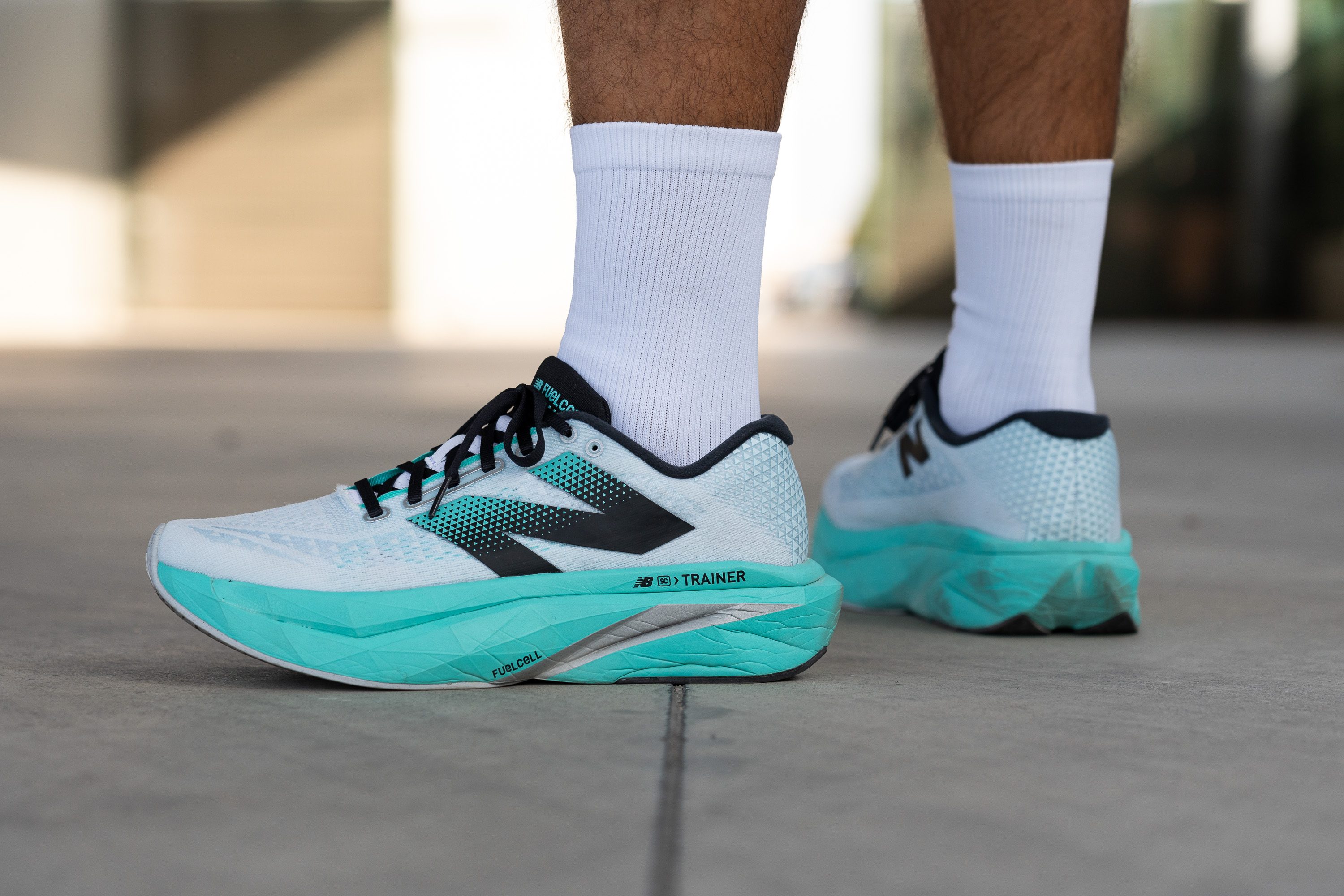
Who should NOT buy
Despite upgrades from version 1 & 2 and an all-new PEBA-blend midsole, we found that the SC Trainer v3 falls short in energy return compared to other supertrainers. For those concerned about this aspect, we recommend considering the Saucony Endorphin Speed 4 or the ASICS Superblast 2, as both offer superior bounce with every stride.
Additionally, our lab tests showed that the SC Trainer v4's weight is a bit higher than ideal, which could deter some runners from opting for this model. If you're looking for a lighter option that still includes the benefits of a carbon plate, the ASICS Magic Speed 4 could be a more suitable supertrainer that also offers more stack height.
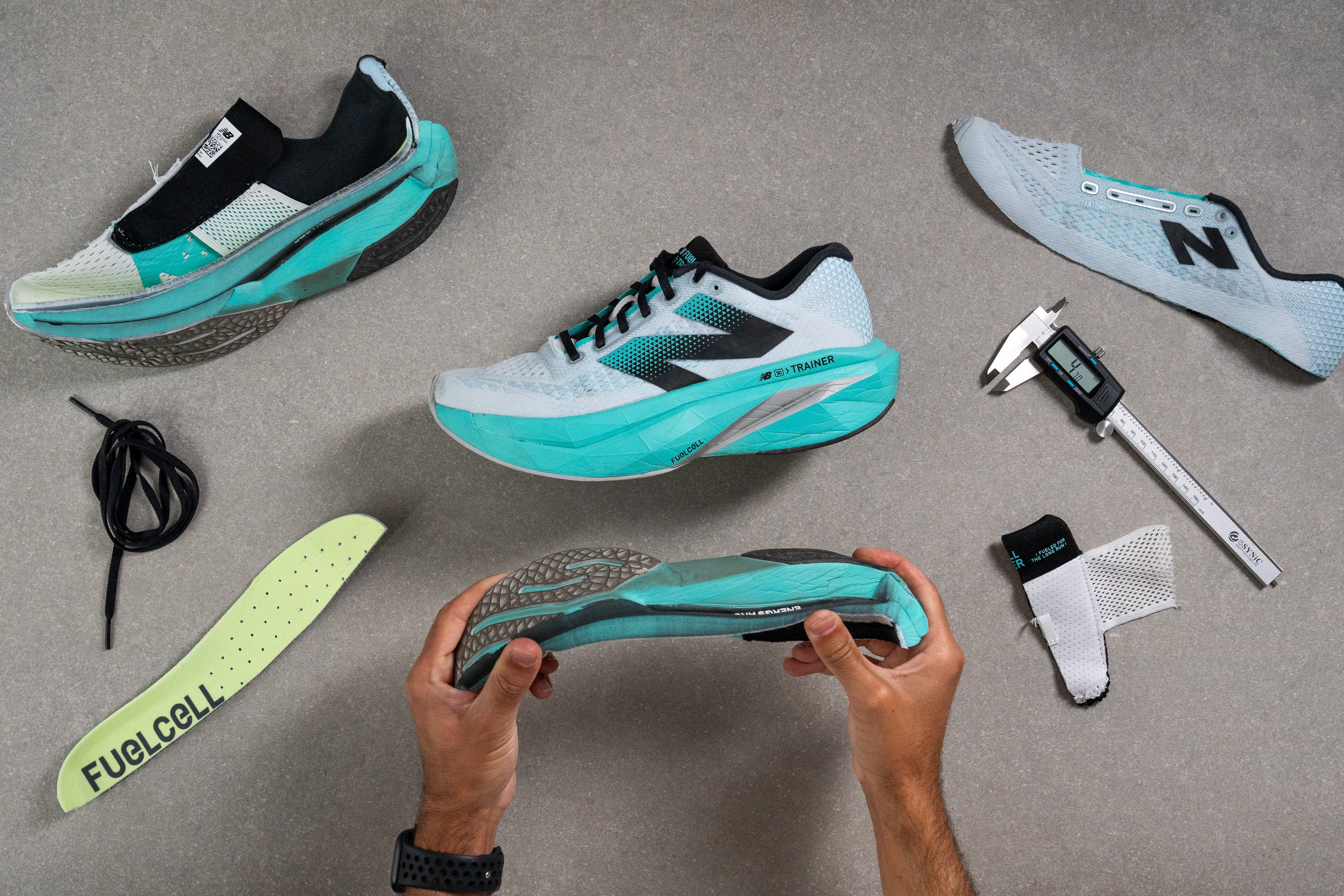
Cushioning
Shock absorption
The Trainer v3 is a great companion for tackling brutal long runs, thanks to its massive shock absorption: 144 SA in the heel and 118 SA in the forefoot. There’s no way you’re bottoming out this beast.
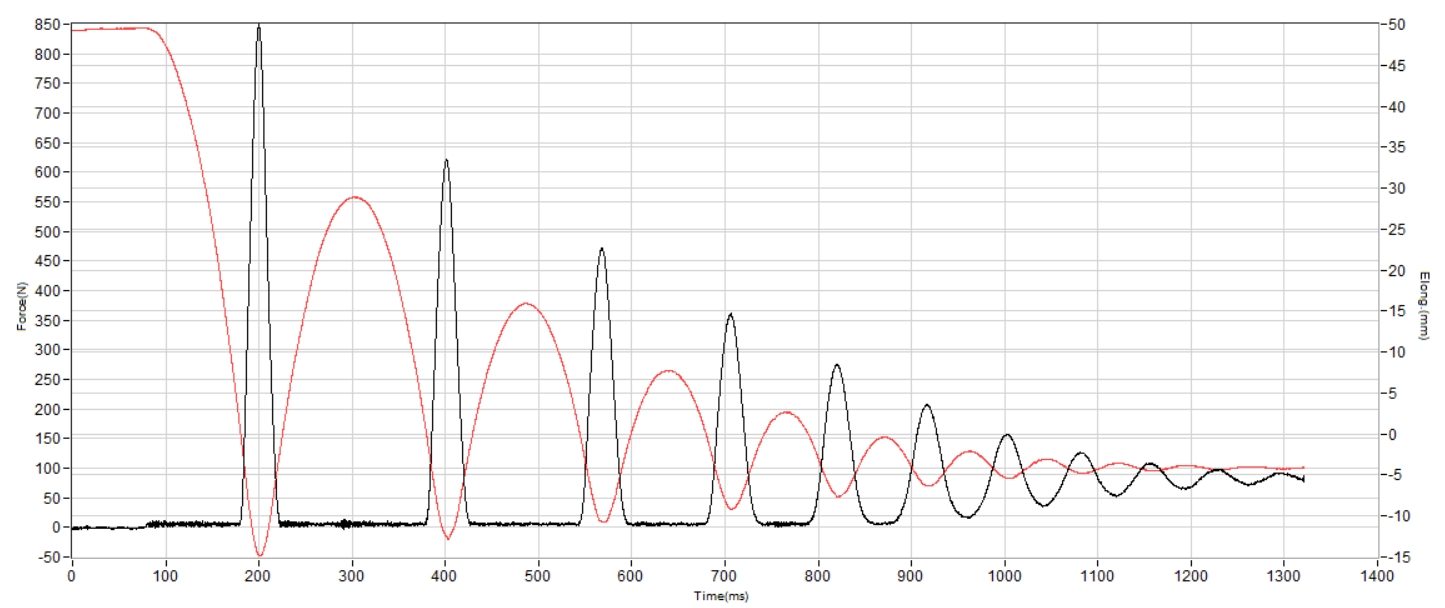
| FuelCell SuperComp Trainer v3 | 144 SA |
| Average | 129 SA |
Energy return
Energy return is solid at 66.1%, though not quite at supershoe level. It sits between daily trainers—typically around 55%—and top-tier racing shoes that hit 70% or more. That makes sense, given this shoe uses a blend of EVA and PEBA, which we’ll break down shortly.
| FuelCell SuperComp Trainer v3 | 66.1% |
| Average | 58.5% |
Heel stack
It’s interesting to observe that while most running shoes are increasing in height each year, the SC Trainer is actually getting lower with each version. The original model started with a heel height of 40.2 mm, then New Balance reduced it to 39.3 mm, and now it's at 36.8 mm.
Whether this reduction is beneficial depends on your preferences. We've noted that those who prioritize stability will appreciate this change, as the lower stack height balances the super-soft midsole, resulting in a more stable ride. However, enthusiasts of ultra-cushioned, maximalist shoes might find it lacking and could consider the Hoka Skyflow for a more protective ride at a similar price.
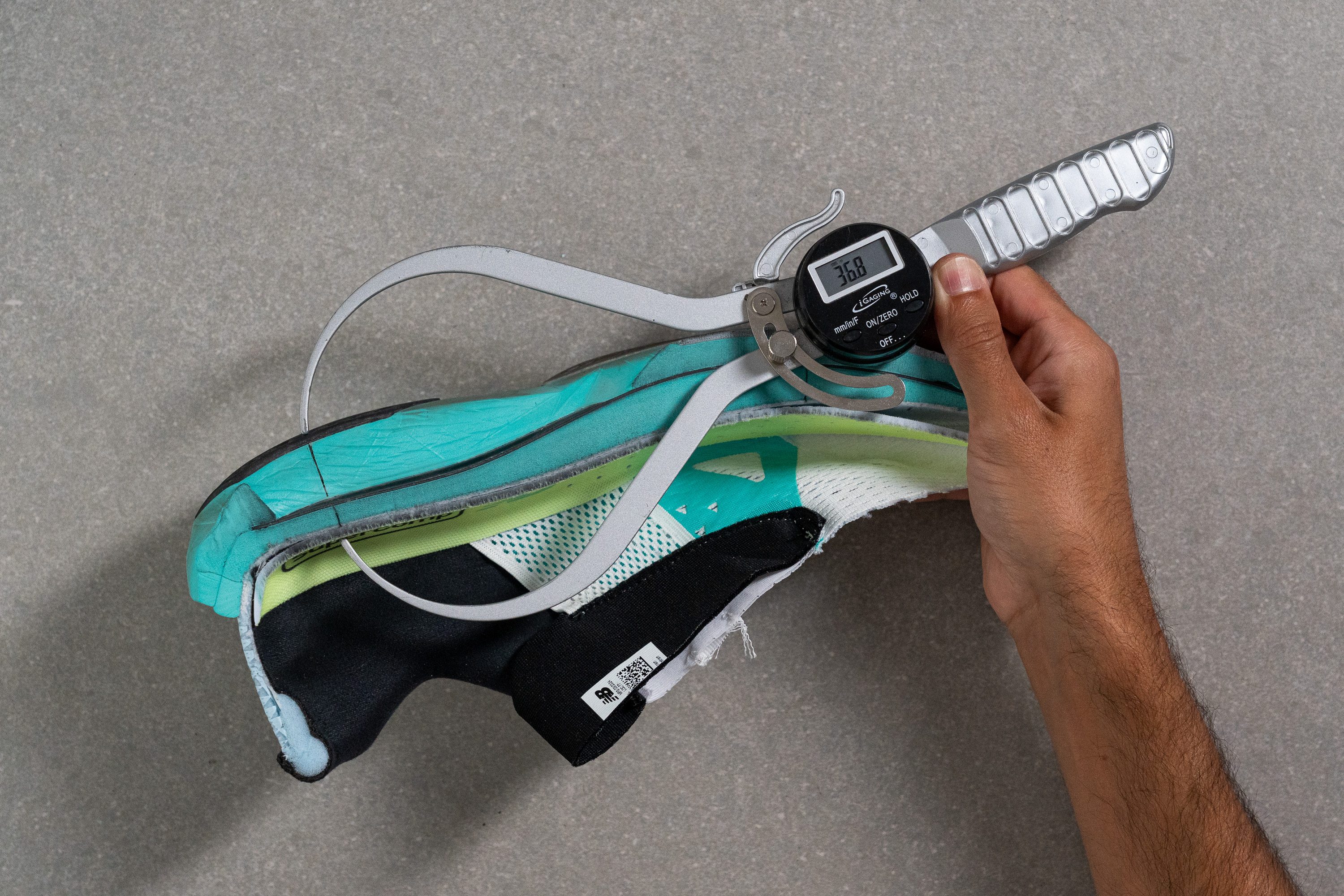
| FuelCell SuperComp Trainer v3 | 36.8 mm |
| Average | 34.8 mm |
Forefoot stack
The forefoot features a substantial 29.5 mm thickness, offering a generous stack height that is ideal for both midfoot and forefoot strikers.
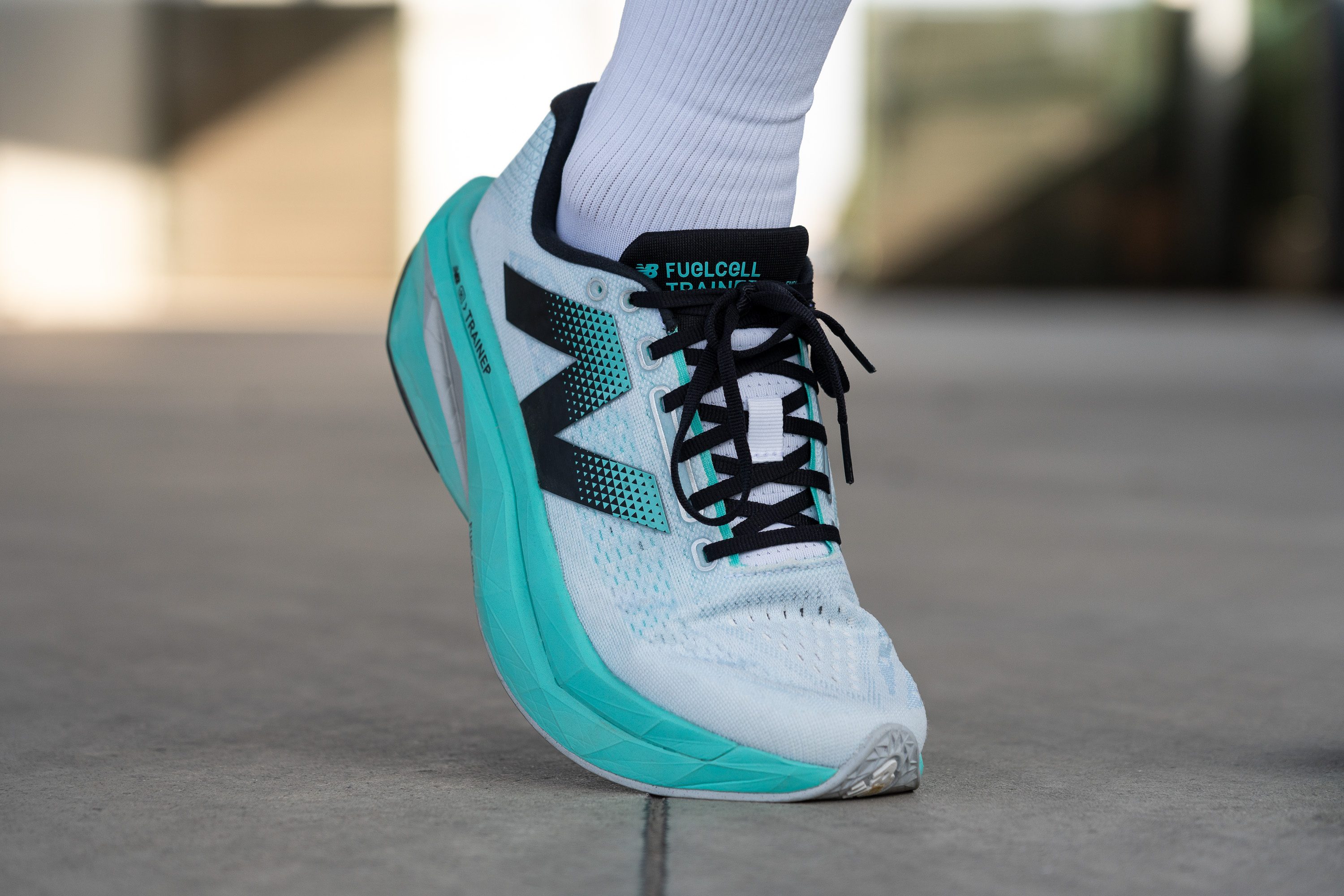
This design makes the shoe exceptionally well-suited for handling the demands of long runs, particularly for marathoners. In fact, we believe this is one of the primary applications for this shoe.
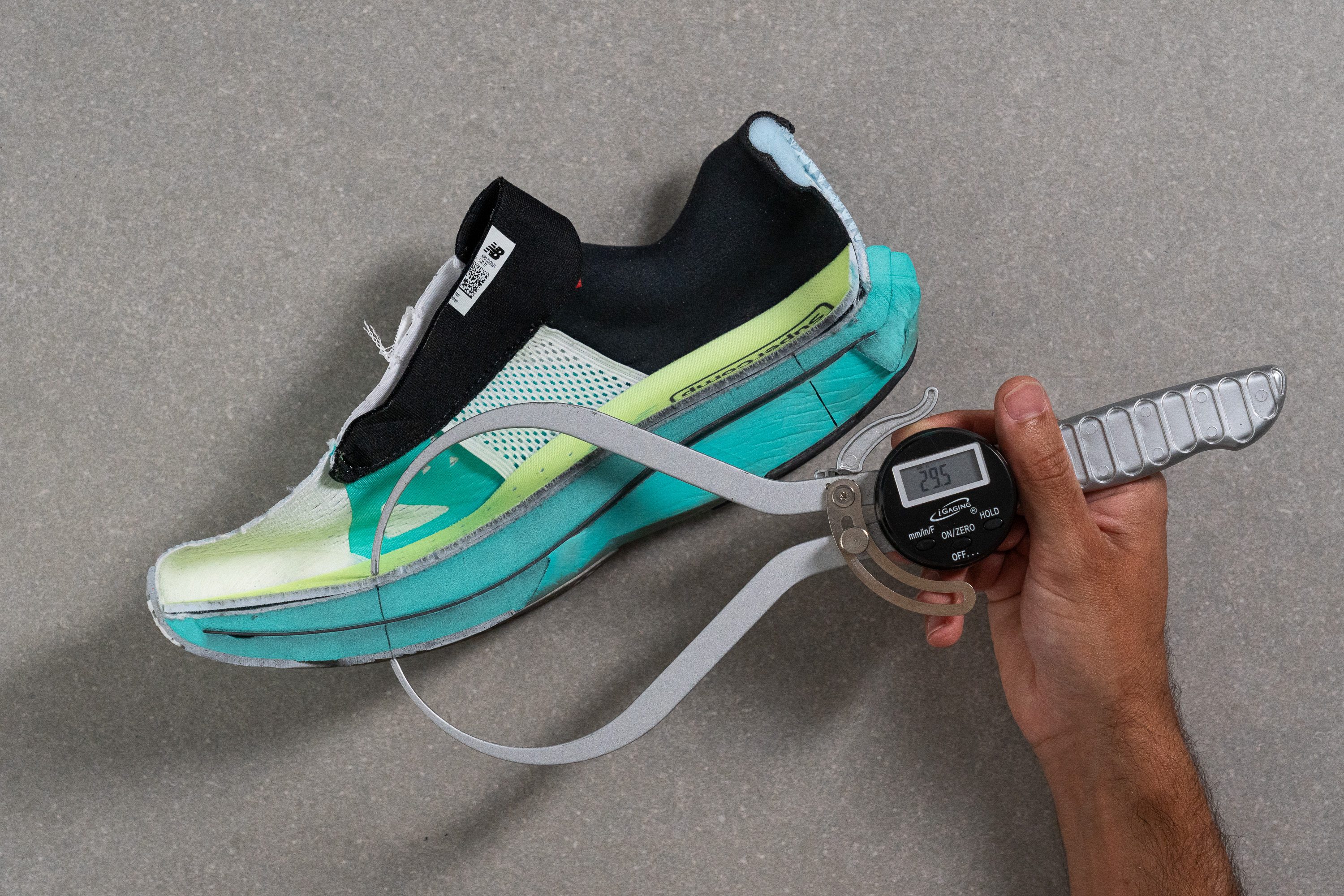
| FuelCell SuperComp Trainer v3 | 29.5 mm |
| Average | 26.2 mm |
Drop
After calculating from the previous two measurements, we determined a 7.3 mm drop. This makes the shoe suitable for all types of footstrikes, but we feel it's especially perfect for midfoot strikers.
This measurement also aligns closely with the official 6 mm drop reported by New Balance, so we have no issues there!
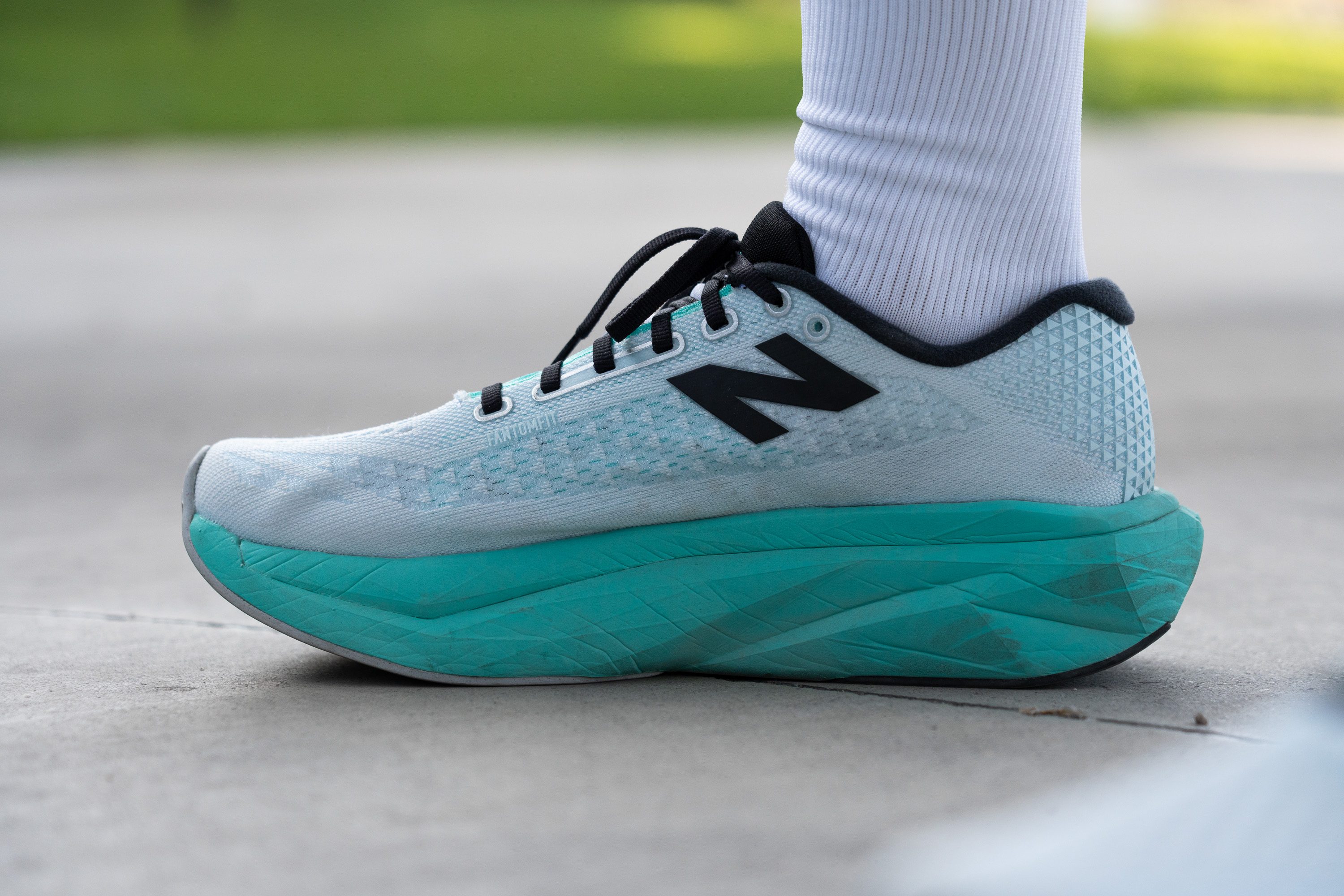
| FuelCell SuperComp Trainer v3 | 7.3 mm |
| Average | 8.6 mm |
Midsole softness
The most significant update in the SC Trainer v3 is the new formulation of FuelCell foam. While you might recall that version 2 also featured FuelCell, this iteration is way different.
As we've discussed in our guide on running shoe foams, brands often use the same name for different materials, and this time, it's not the old FuelCell from a year or two ago but a new blend of 20% PEBA and 80% EVA.
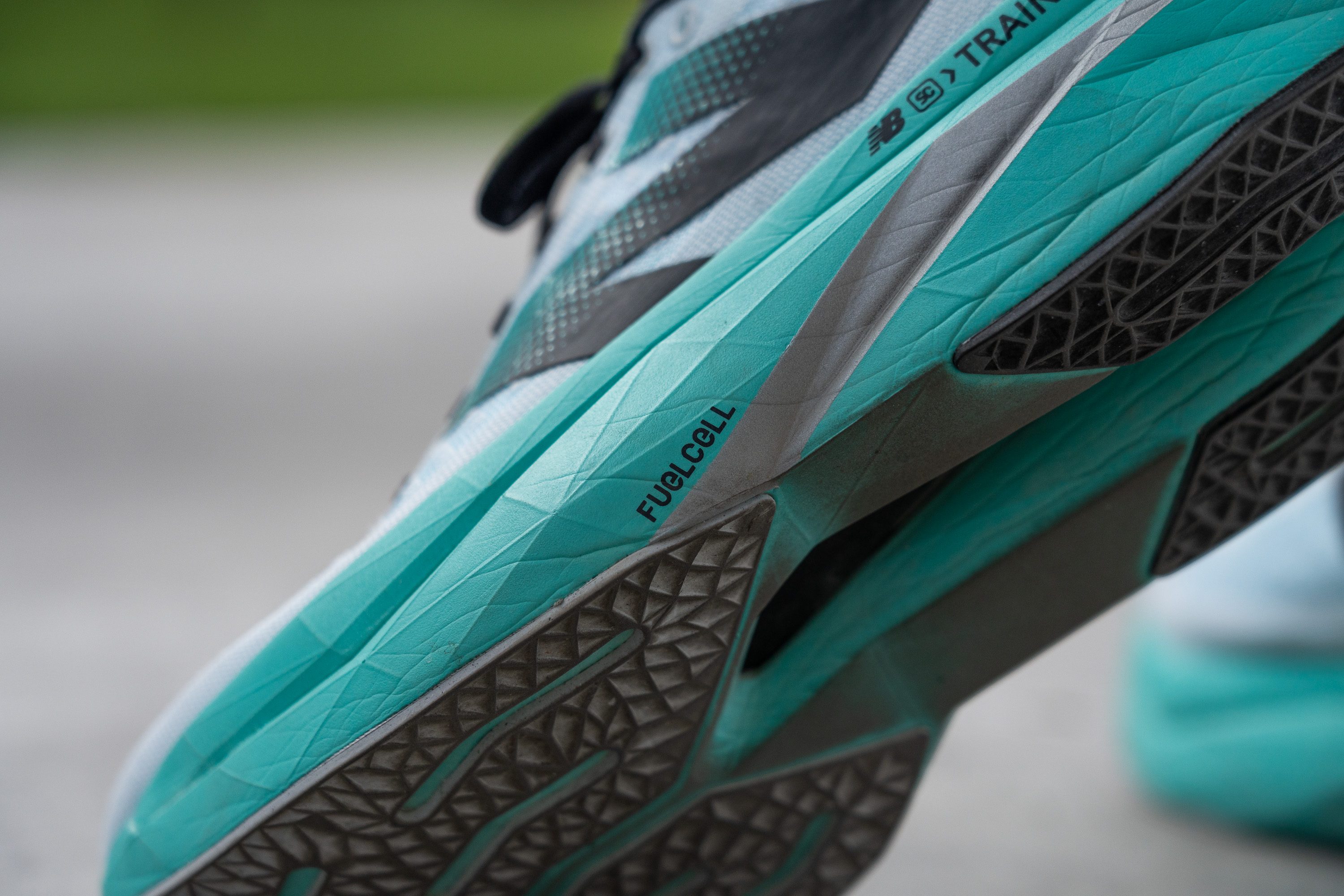
Contrary to the top-tier Elite v4, which boasts a 100% PEBA midsole—our preferred choice for performance—New Balance opted for more durability and affordability. They've used the previously mentioned blend of PEBA and EVA.
This mix is decent and maintains the characteristic pillowy-soft feel synonymous with all FuelCell foams, likely the reason behind keeping the name. And while it may not be the bounciest out there, with a softness rating of 8.8 HA on our durometer, we can confirm that it certainly feels like running on clouds.
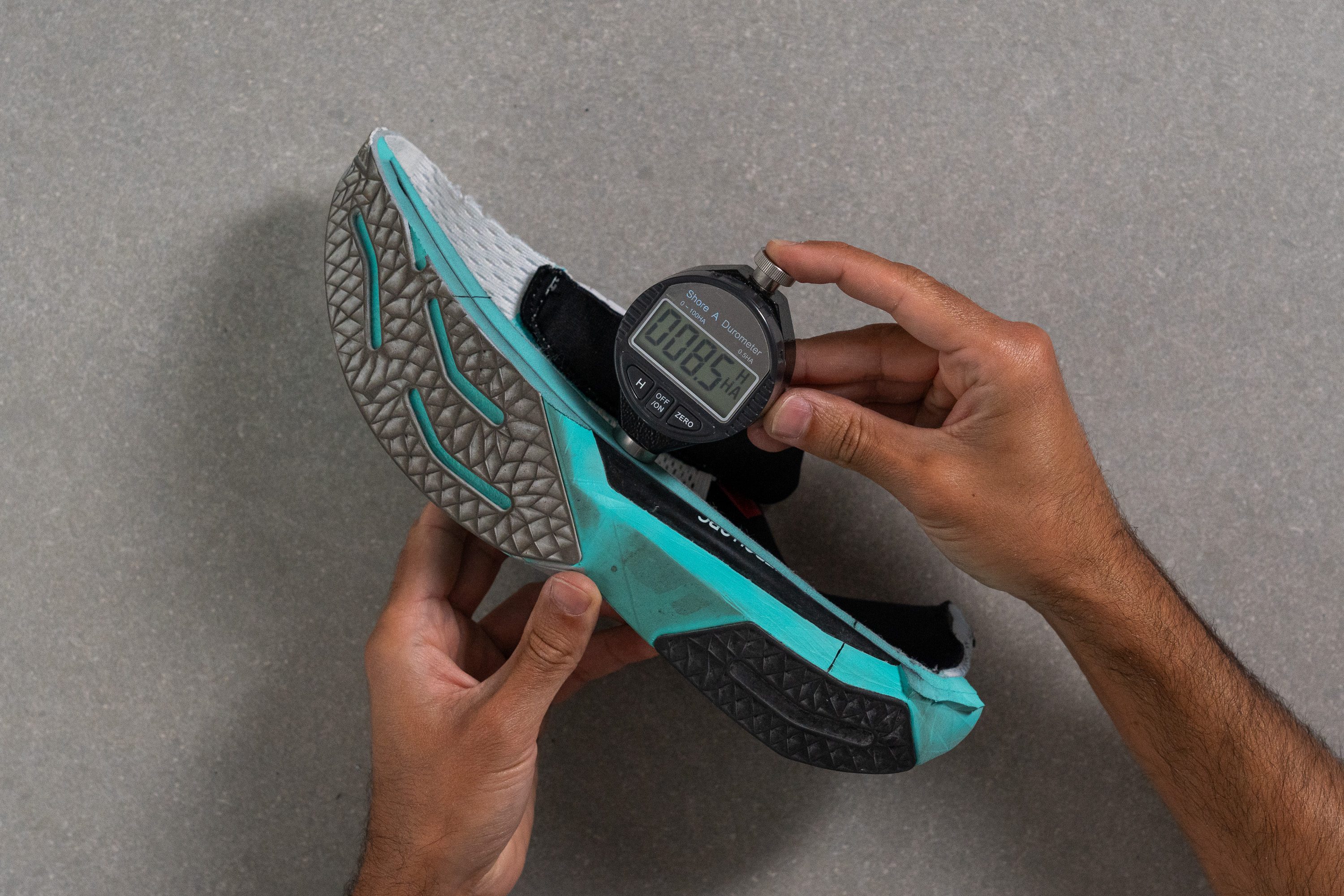
| FuelCell SuperComp Trainer v3 | 8.8 HA |
| Average | 20.4 HA |
Rocker
Both previous versions of the SC Trainer offered a rockered ride despite significant changes in design and stack height, and version 3 continues this trend with minor changes.
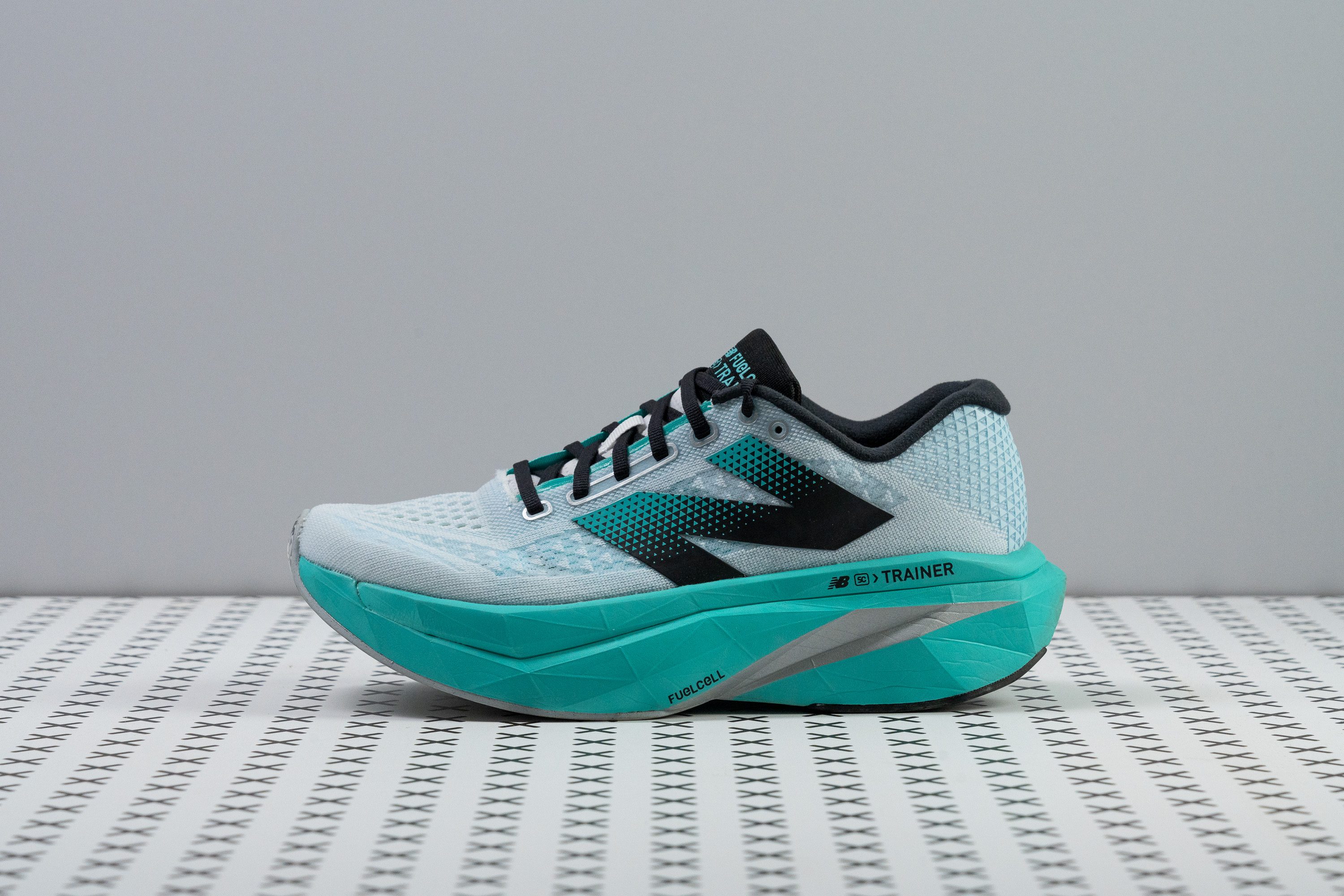
It features a pronounced rocker in the forefoot and a heel bevel too, essential due to its stack height and carbon plate, though it is not as dramatically curved as the Hoka Cielo X1 or the SC Trainer v2.
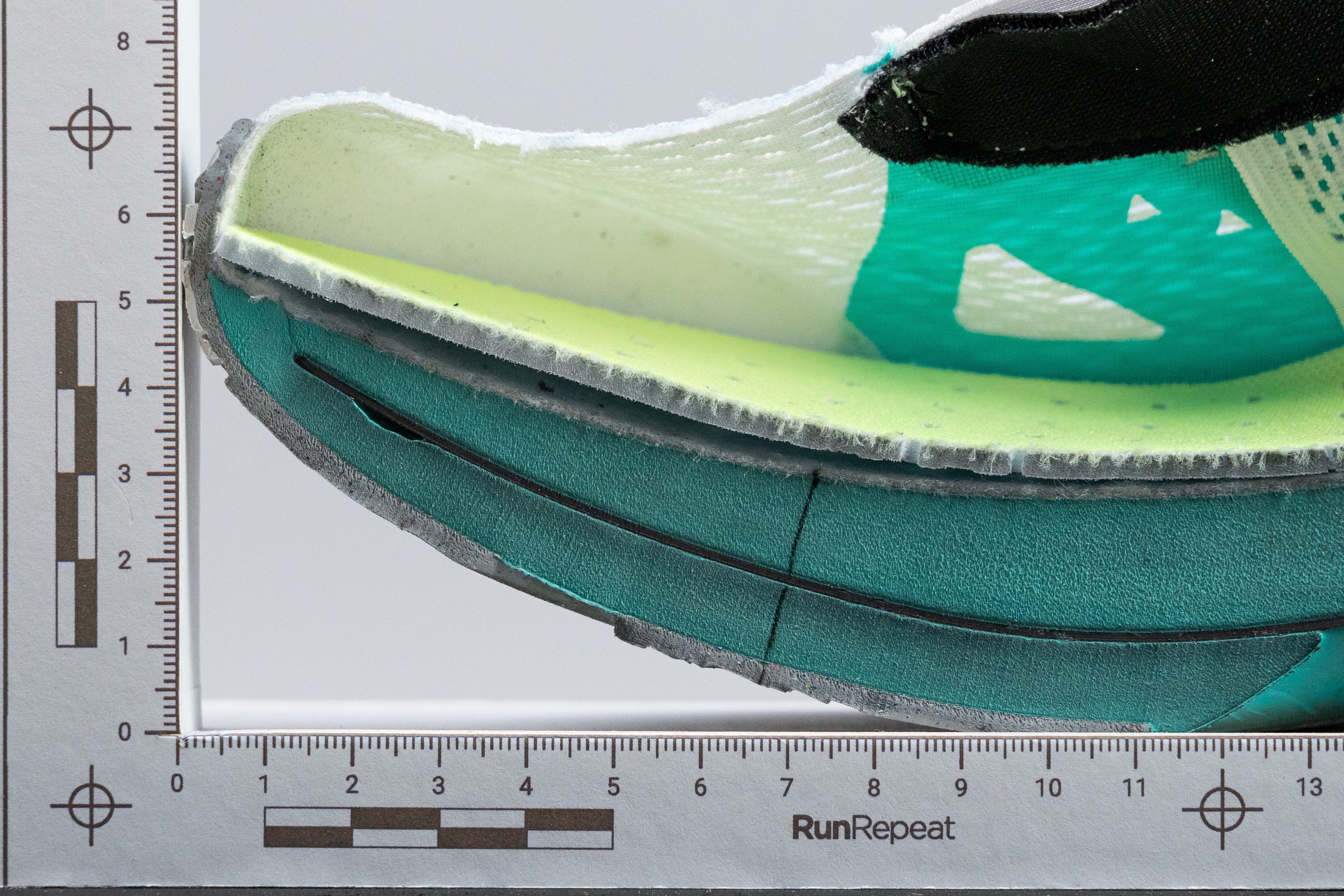
Plate
The SC Trainer v3 features a full-length Energy Arc plate, which is more than just a fancy name. Rather than using a flat plate against a full slab of foam, New Balance has paired an open channel in the midsole with a concave plate to, supposedly, enhance energy return.
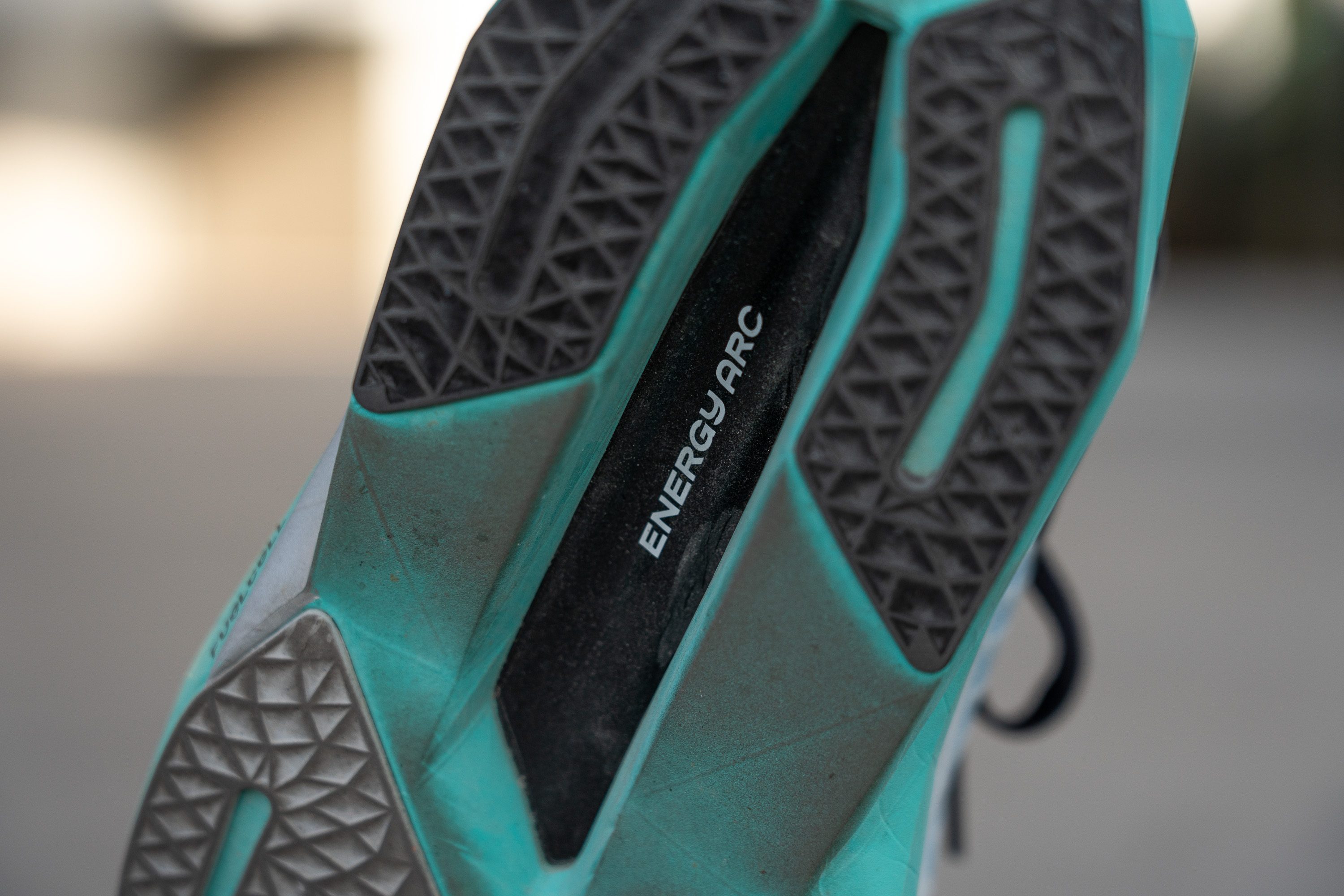
Does it work? While we can't definitively say, we're hopeful, as the trade-off is that the shoe tends to catch pebbles if you run on gravel roads. What we can confirm though is that despite being made from carbon fiber, it feels less aggressive and stiff compared to most racers. And that makes sense for a uptempo training shoe.
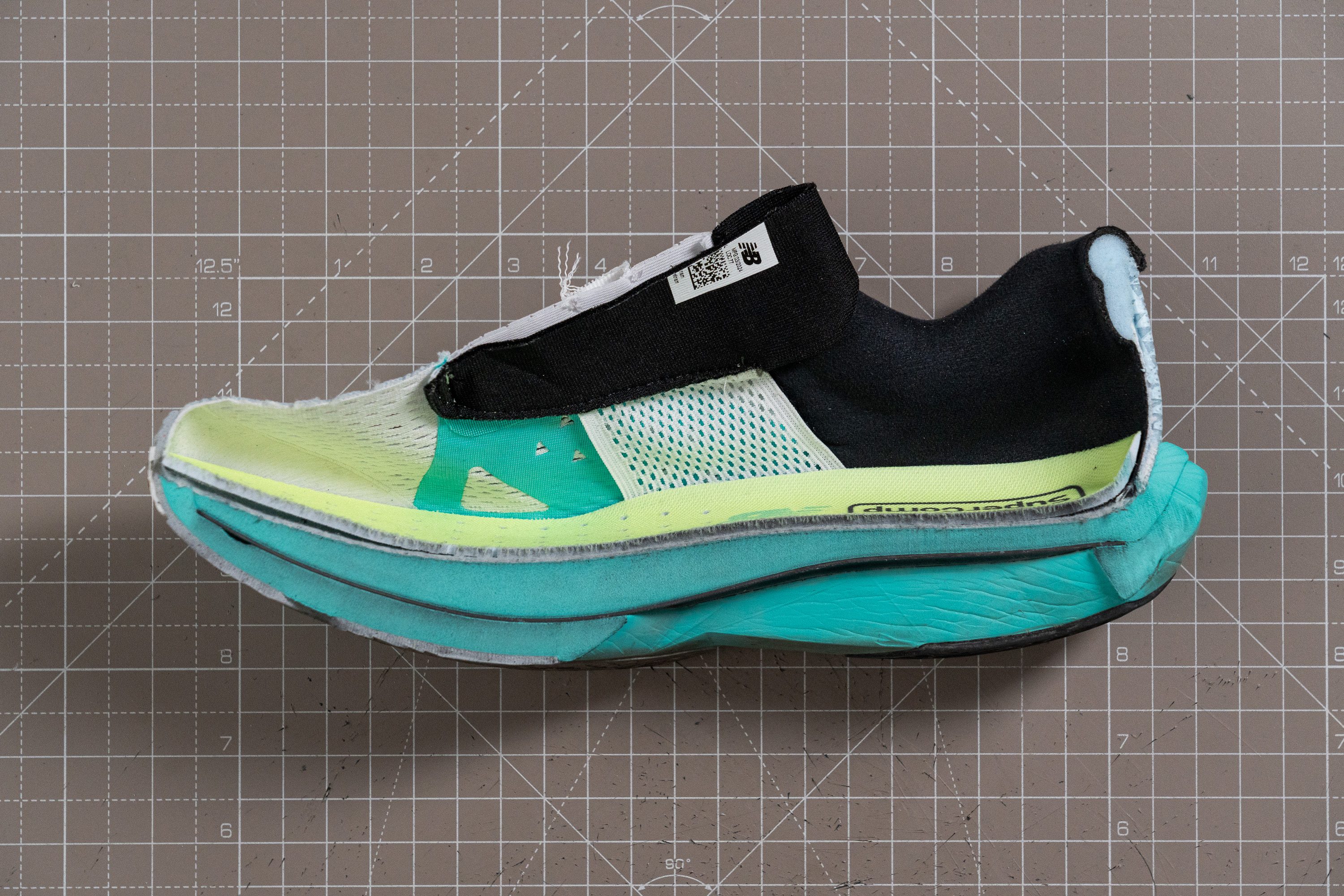
Size and fit
Size
New Balance FuelCell SuperComp Trainer v3 fits true to size (75 votes).
Width / Fit
To evaluate the fit, we used a custom gel mold we carefully prepared and cooled in the lab.
From our first trial of the SuperComp Trainer v3, we noticed its average width at 95.9 mm. This makes it a good option for long runs, especially those stretching beyond two hours, where comfort becomes paramount.

| FuelCell SuperComp Trainer v3 | 95.9 mm |
| Average | 95.1 mm |
Toebox width
Our second measurement, taken in the big toe area, showed a width of 73.5 mm. This provides a secure fit for most runners, though those with wider feet might feel restricted—considering a less-tapered option like the Mizuno Neo Vista as a suitable alternative.

| FuelCell SuperComp Trainer v3 | 73.5 mm |
| Average | 73.2 mm |
Toebox height
From the start, we noticed the vertical space inside the toebox felt slightly restricted.
Now we understand why—our vernier caliper measured it at just 25.9 mm. While this offers a tiny bit less vertical space than many shoes, we believe it suits runners looking for a snug option for tempo workouts in their rotation.
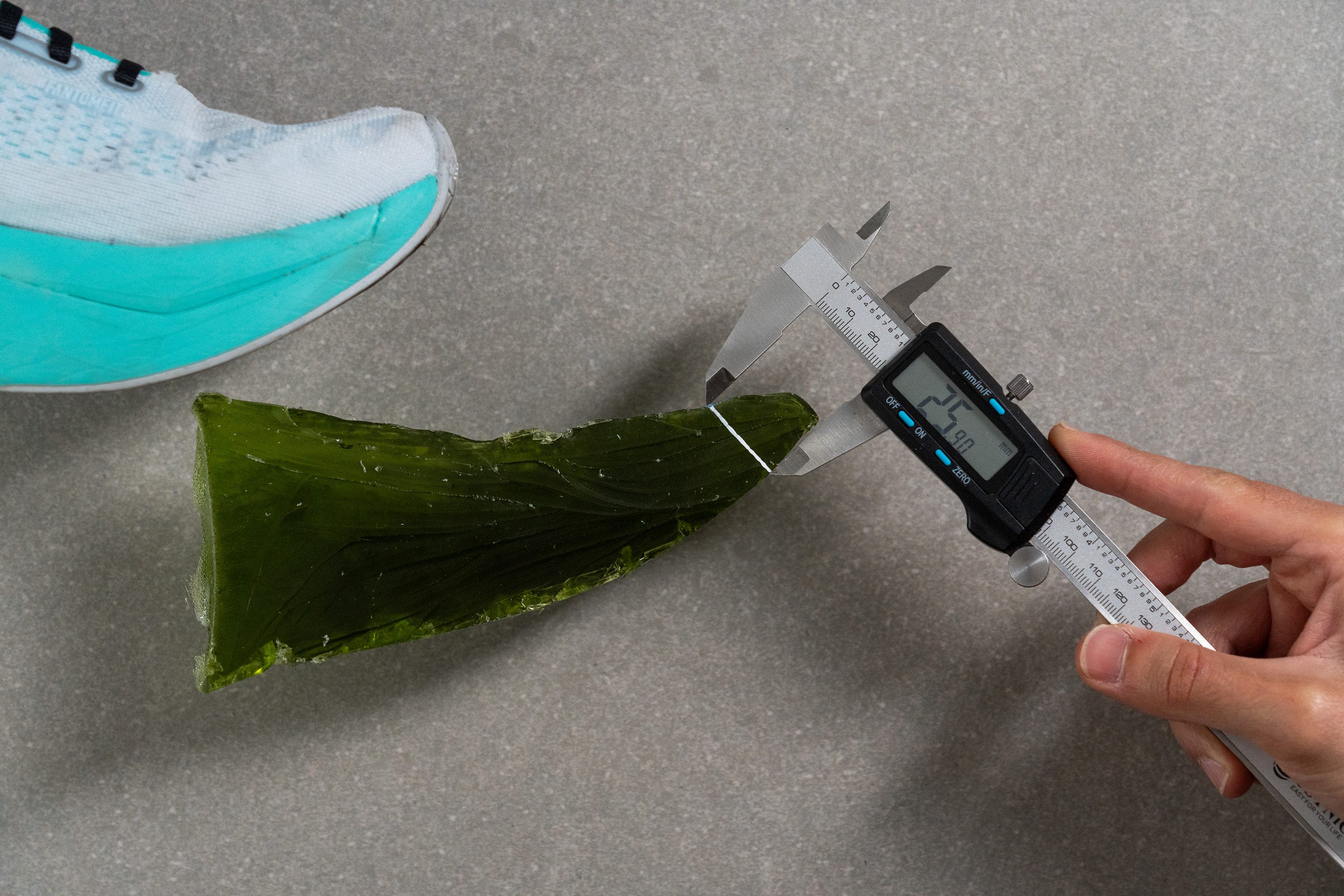
| FuelCell SuperComp Trainer v3 | 25.9 mm |
| Average | 27.1 mm |
Traction / Grip
Traction test
The rubber blend of this New Balance shoe showed a solid friction score of 0.51 in our SATRA TM144 grip test. It may not be the tackiest outsole compound in a tempo shoe but it has enough bite to keep you skid-free on wet concrete.
And if you want that supreme traction in a speed trainer, try the ASICS Magic Speed 4 (0.81) or the PUMA Deviate Nitro 3 (0.65).
| FuelCell SuperComp Trainer v3 | 0.51 |
| Average | 0.48 |
Outsole design
The SC Trainer v3 uses a race-inspired outsole with rubber only in the areas that hit the ground the most. The entire center is cut out to reduce weight and highlight the exposed carbon plate. While heel and forefoot zones get decent protection, the rubber coverage is clearly dialed back compared to most max-cushioned trainers.
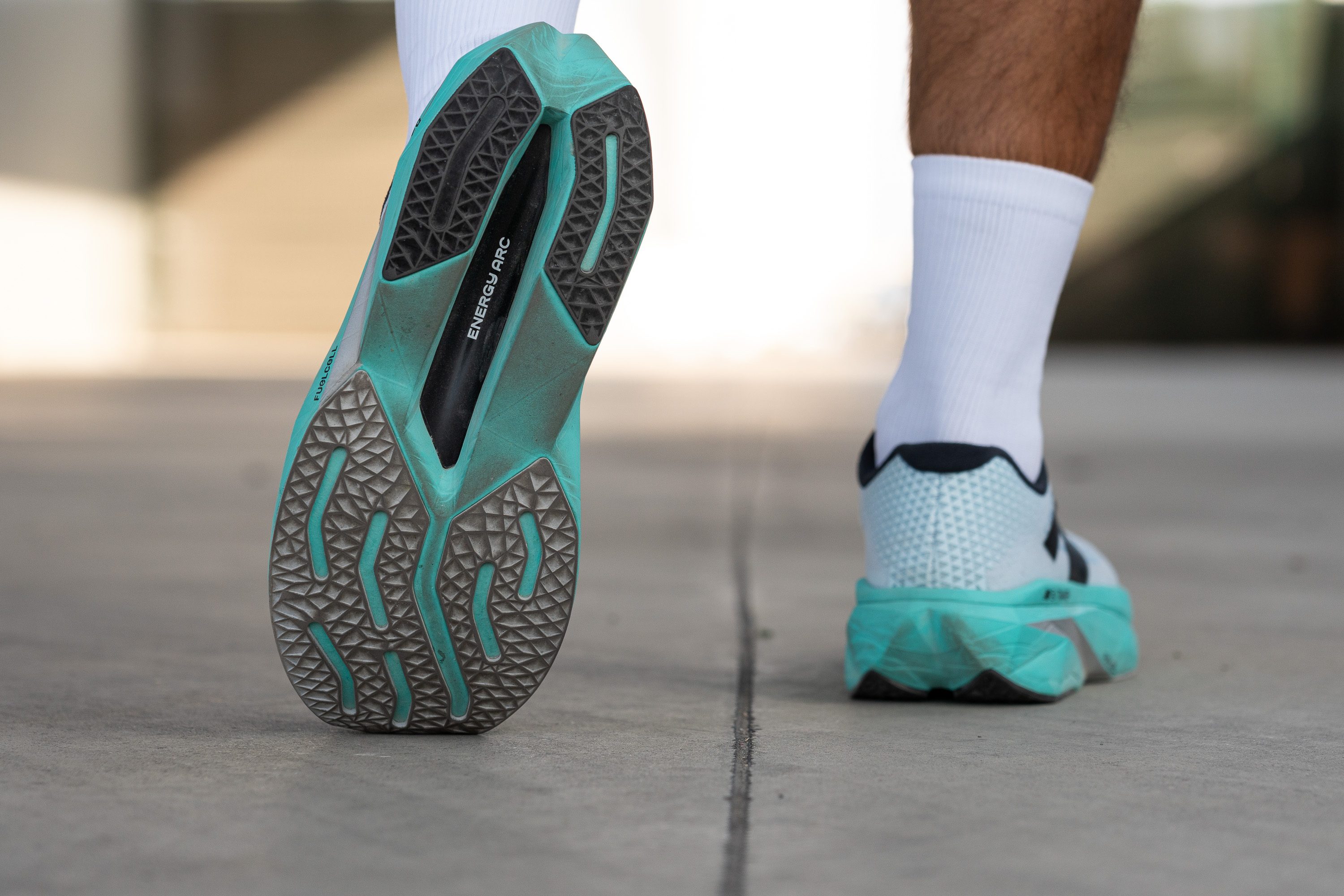
Flexibility / Stiffness
Using a carbon plate in a training shoe often risks making it too stiff. In the case of the SC Trainer v3, those chasing a flexible ride won’t find it—it scored 25.1N in our flex machine. But that result shouldn’t come as a surprise, as it’s nearly impossible for a shoe with carbon in the midsole to score below average in this test.
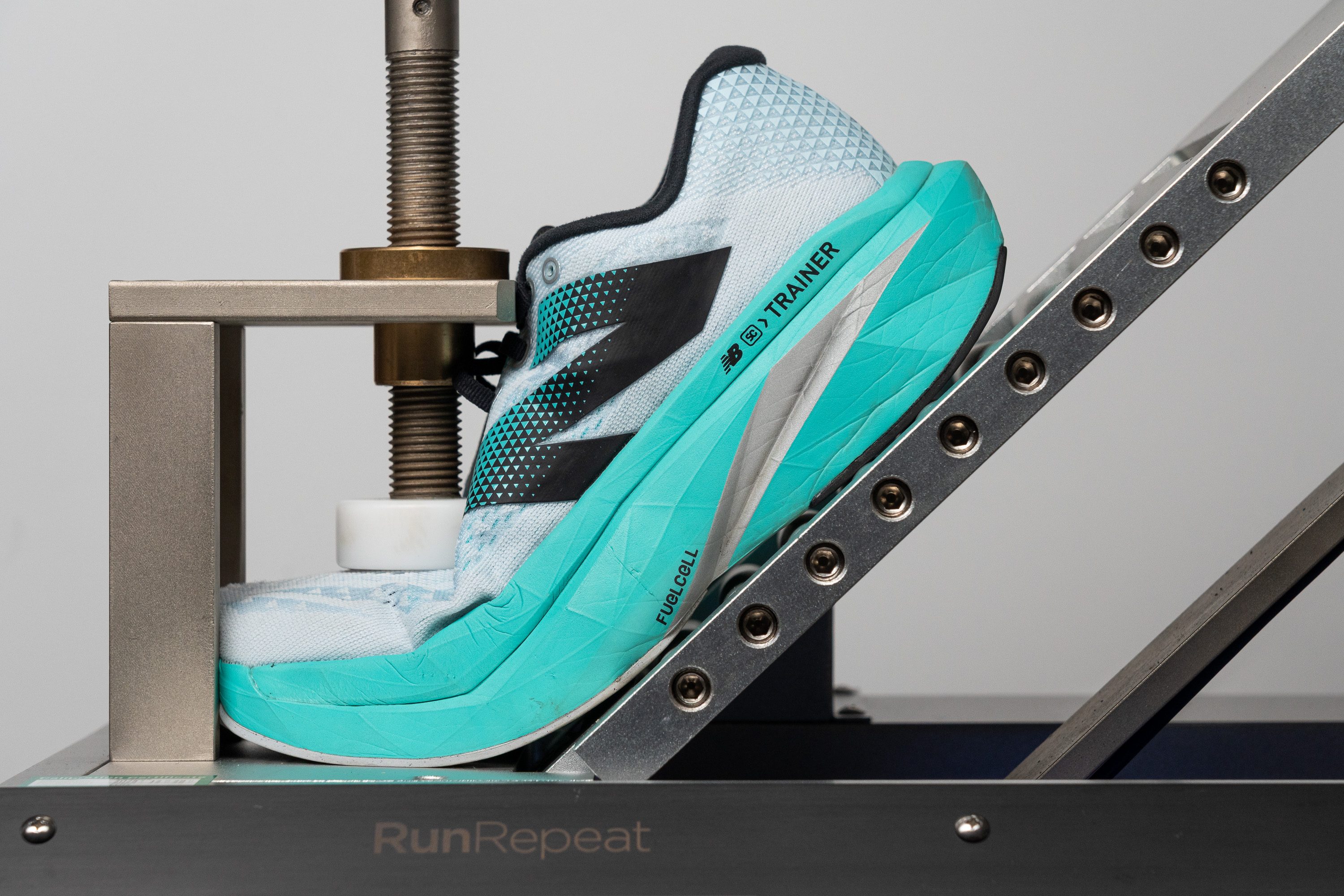
| FuelCell SuperComp Trainer v3 | 25.1N |
| Average | 15.3N |
Weight
Here's another aspect of New Balance's SC Trainer evolution that leaves us baffled. The first generation was notably heavy at 10.5 oz, and the second generation dropped significantly to a more manageable 9.3 oz.
Now, the latest version settles in the middle at 9.8 oz or 278g. While not a deal-breaker, this weight is still heavier than many performance trainers that boast even higher stack heights, like the On Cloudmonster Hyper. It undoubtedly feels like a step back for us.
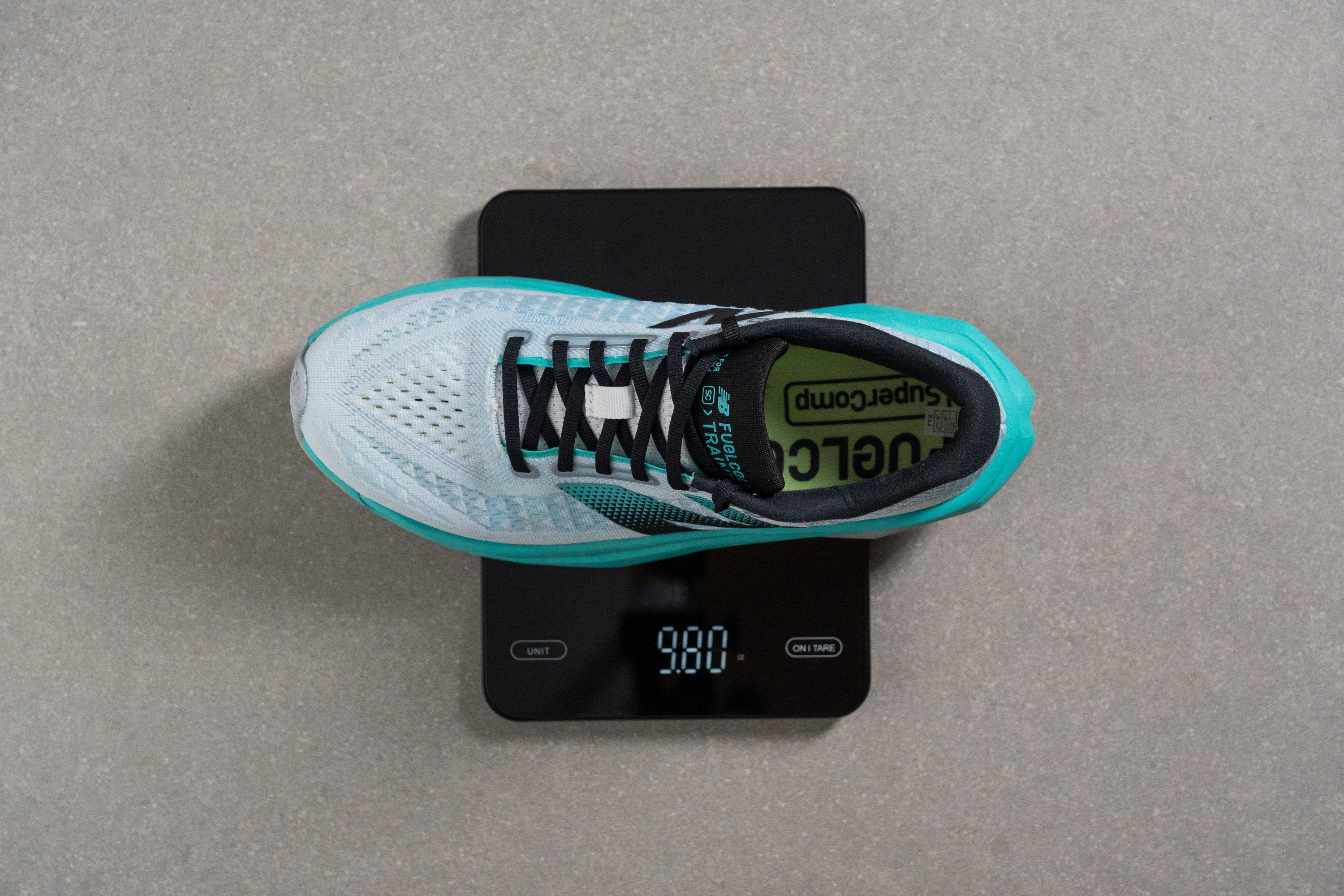
| FuelCell SuperComp Trainer v3 | 9.8 oz (278g) |
| Average | 9.3 oz (264g) |
Breathability
The SC Trainer v3 bears a striking resemblance to its racing-oriented sibling, the Elite v4, largely due to its incorporation of the FANTOMFIT upper.
In our evaluation, the upper scores a solid 4 out of 5 for breathability, thanks primarily to the large ventilation holes in the toebox area.
However, we noticed that the rest of the shoe lacks significant airflow, which could be a concern for some. Our examination revealed that New Balance strategically designed the shoe's structure to enhance stability, addressing previous complaints. And we believe this trade-off is definitely worthwhile.
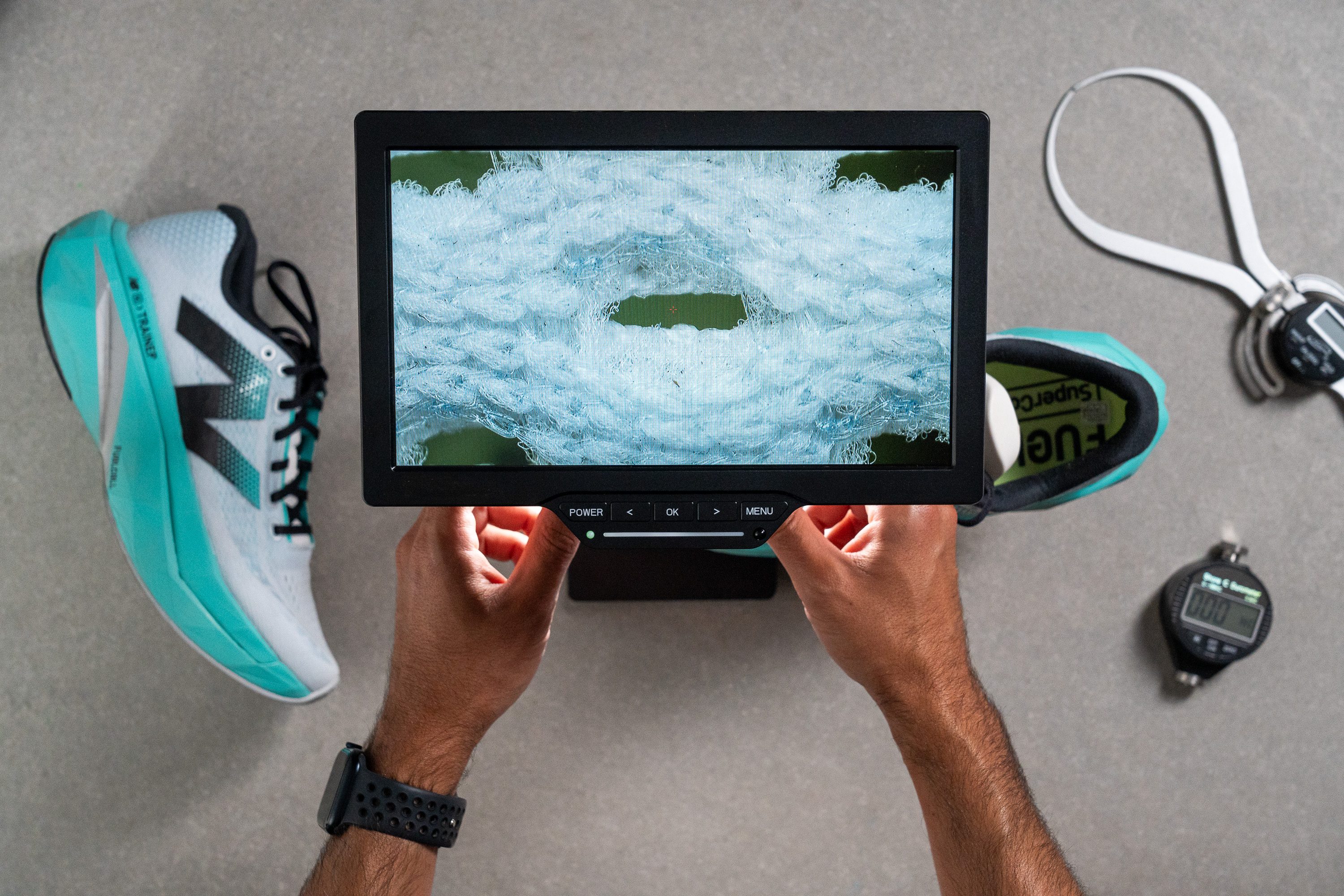
We observed with our microscope these punctured holes that facilitate the escape of hot air. Without them, the shoe would have significantly underperformed in our tests.
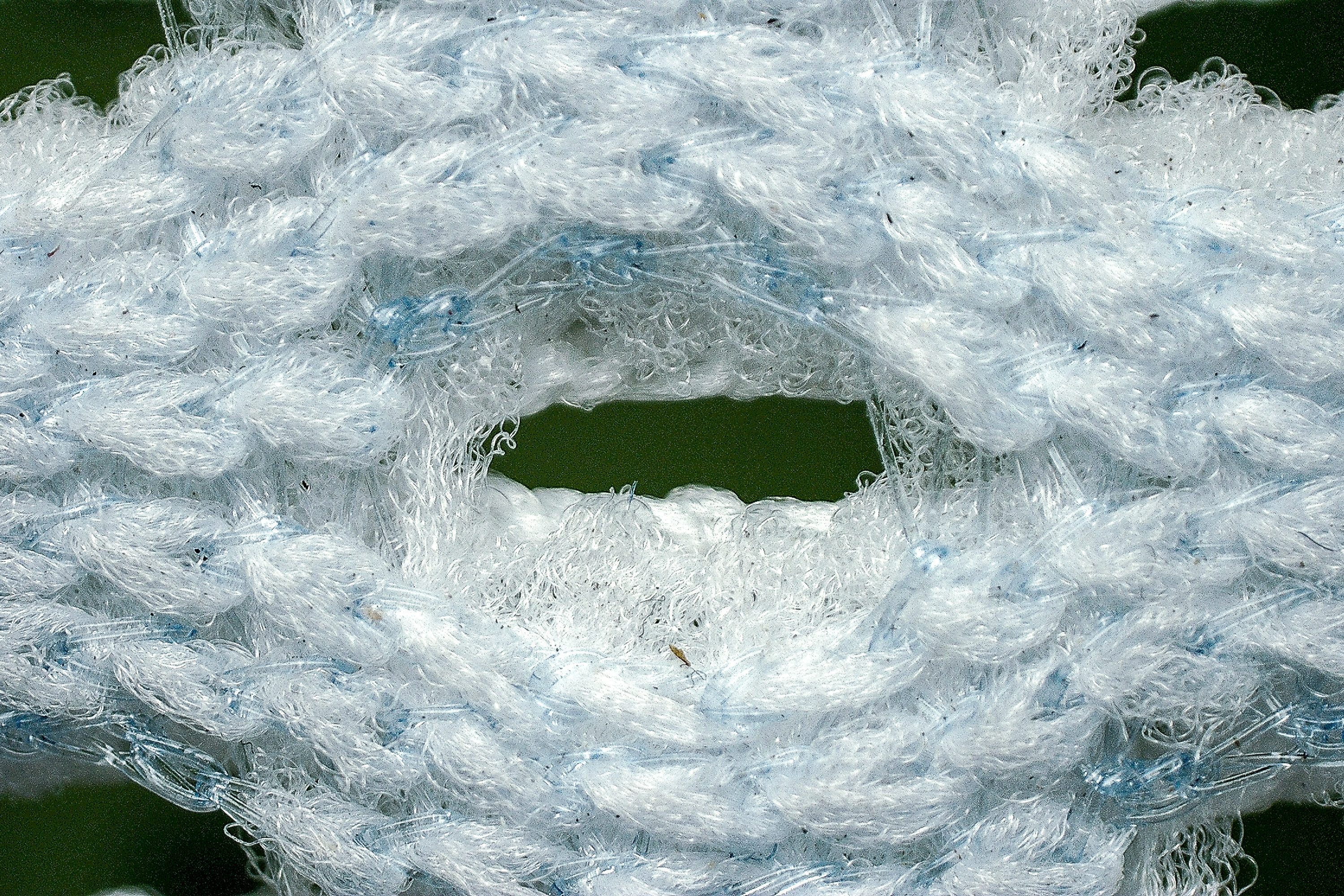
Upon close analysis of the upper, we must acknowledge that New Balance has significantly elevated the quality here. The use of advanced materials and the impressive design make this FAMTOMFIT tech a standout, especially for a model priced under two hundred dollars.
Finally, it's noteworthy how New Balance continues to rethink the SC Trainer on every update. Our images of all three versions, clearly highlight the significant changes with each release—geometry, upper, heel padding and many other details!
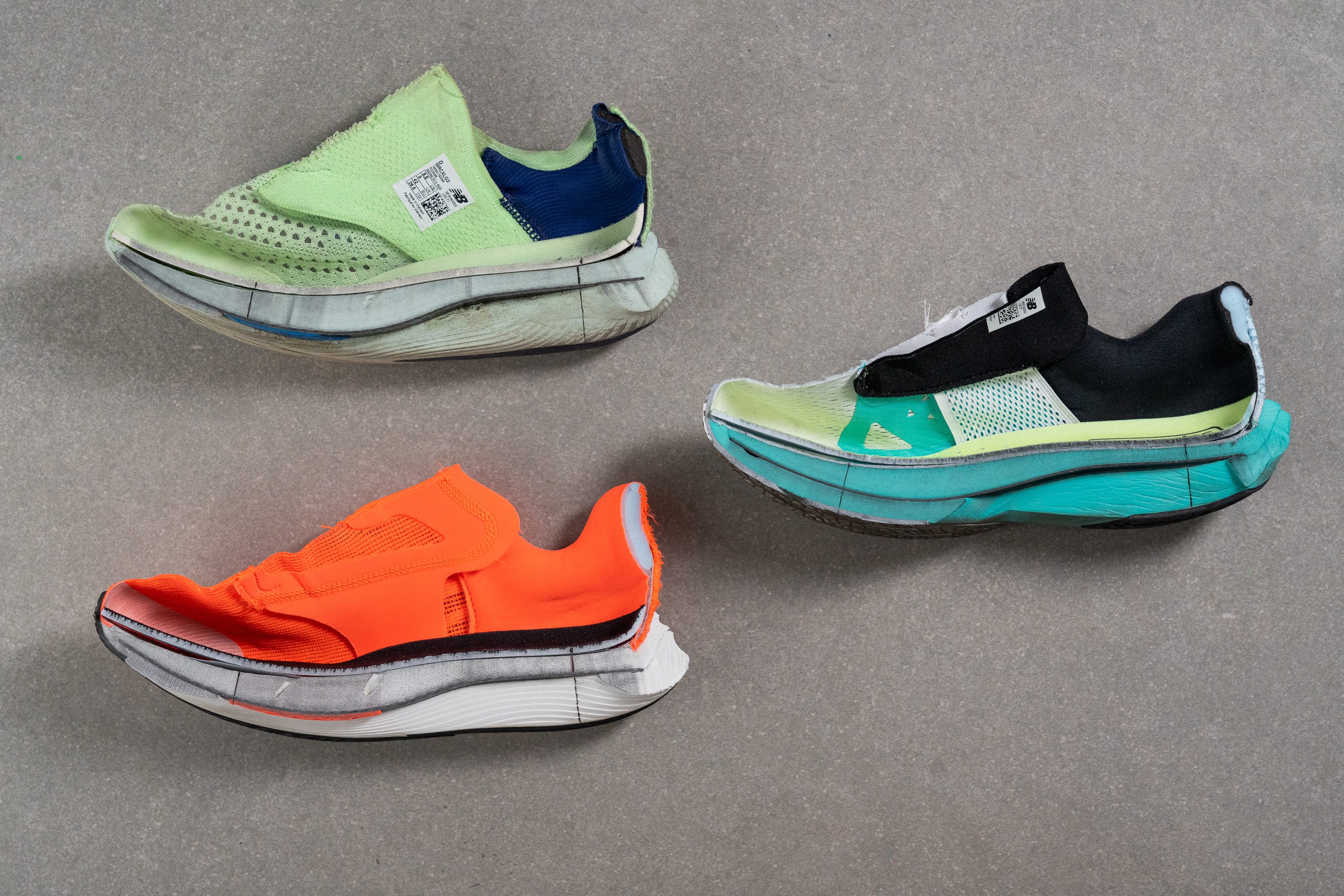
Sure, this demonstrates New Balance's commitment to improvement, which is awesome. However, it also suggests a struggle to perfect this shoe.
| FuelCell SuperComp Trainer v3 | 4 |
| Average | 3.7 |
Stability
Lateral stability test
Despite its high stack height and plush foam, this shoe surprisingly maintains stability. We found that New Balance has impressively integrated numerous non-intrusive guidance elements to achieve this.
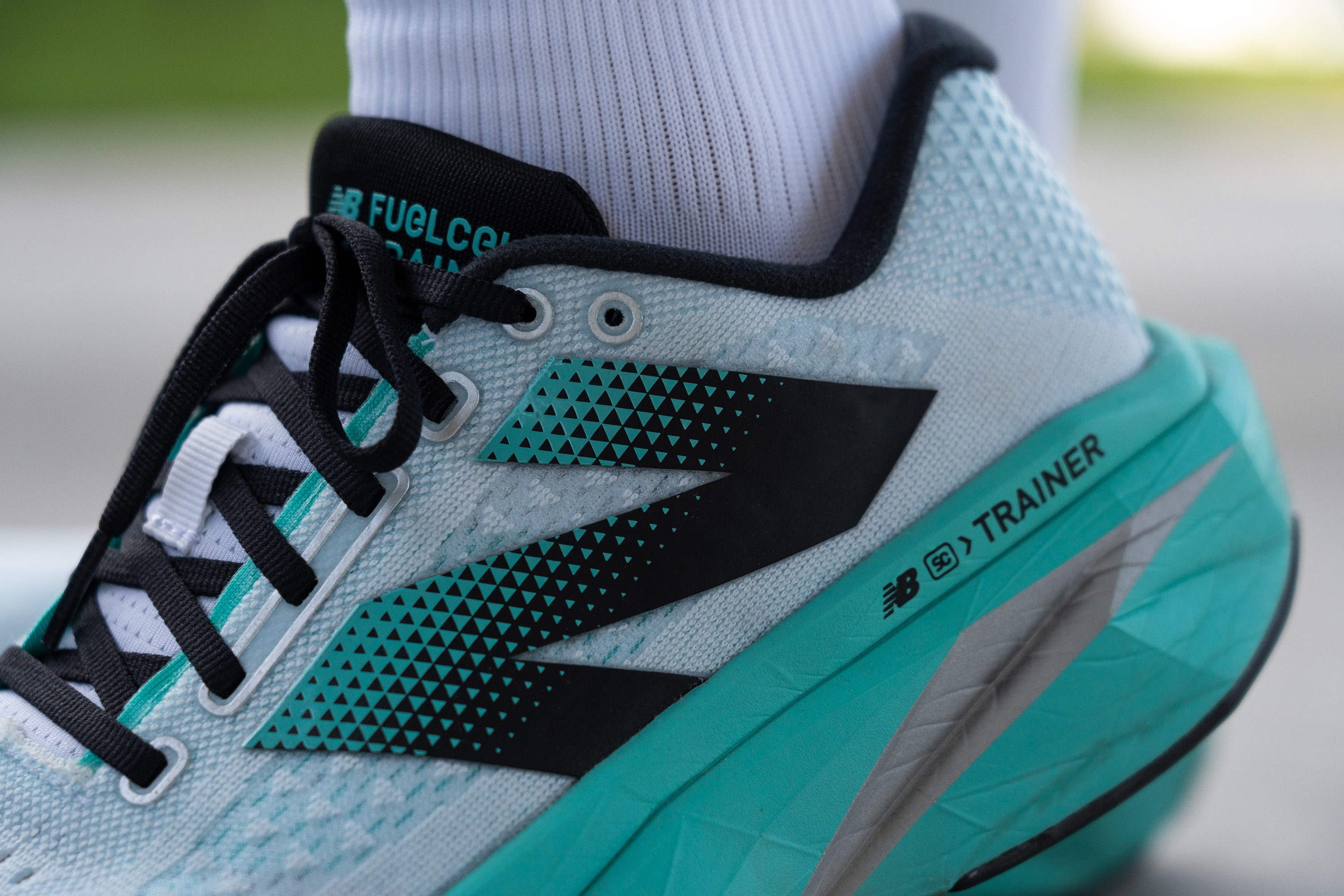
One key feature is the large central groove extending from the heel to the midfoot, which we discussed in the plate section. Additionally, the broad sole flare and raised midsole sidewalls, coupled with the carbon plate, not only stiffen the ride but also significantly enhance support.
Torsional rigidity
Equipped with a carbon plate, the results of this test were expected to be exceptionally high—and that's exactly what we achieved in the lab: a score of 5 out of 5, indicating an incredibly stiff build.
| FuelCell SuperComp Trainer v3 | 5 |
| Average | 3.5 |
Heel counter stiffness
The heel counter truly embodies the "Trainer" aspect of the shoe, scoring a 3 out of 5, which aligns more with a standard daily trainer than any racing shoe. We celebrate this design choice because it contributes a much-needed bit of stability.
| FuelCell SuperComp Trainer v3 | 3 |
| Average | 2.9 |
Midsole width - forefoot
As we noted in our initial analysis of stability, the SC Trainer v3 features a significant sole flare, where the midsole expands laterally to stabilize and center the foot within the shoe.

After testing this on the run and returning to the lab, we measured a substantial 117.7 mm in the forefoot. This measurement, combined with the shoe's geometry and drop, makes the SC Trainer v3 an excellent option for midfoot strikers.
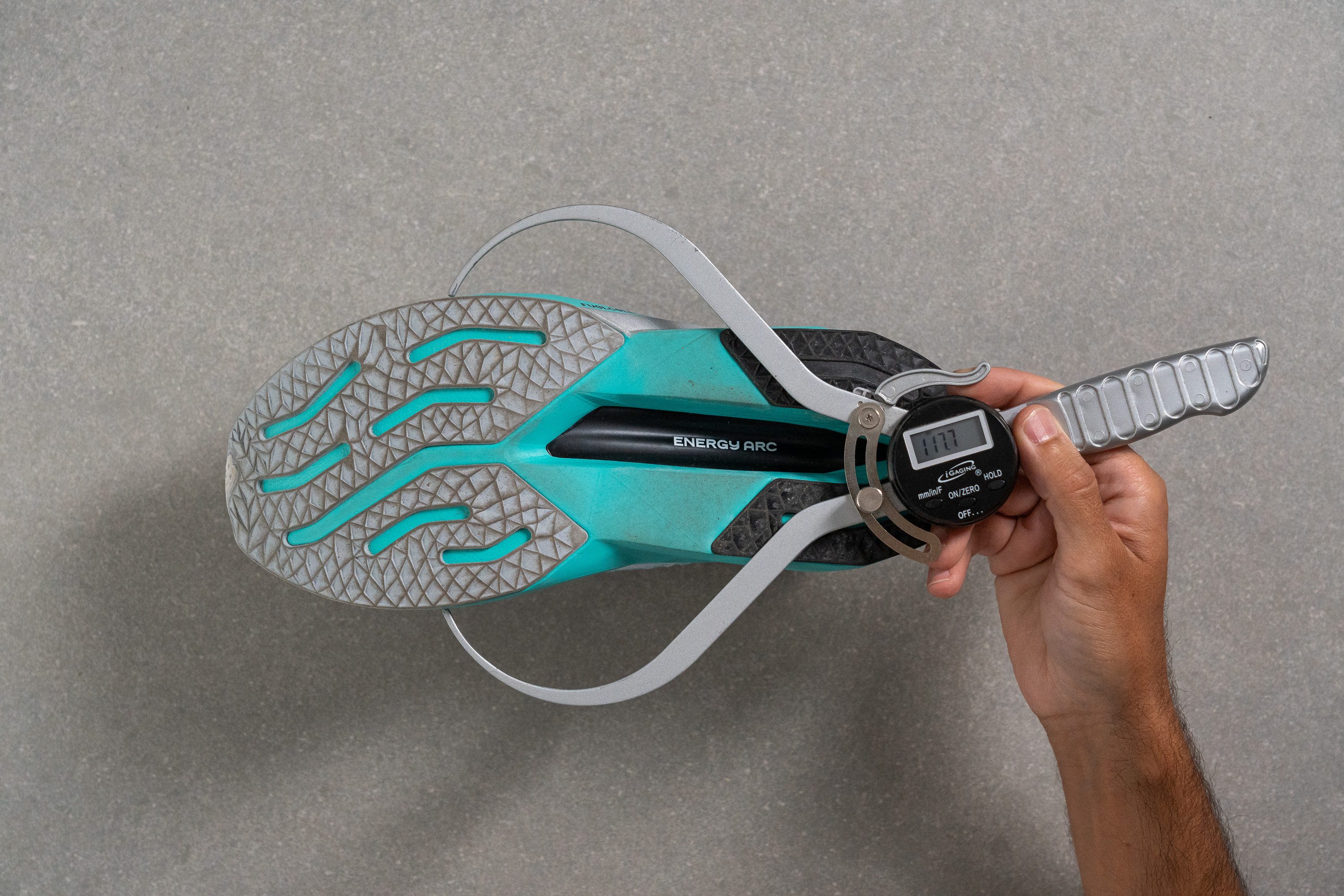
| FuelCell SuperComp Trainer v3 | 117.7 mm |
| Average | 114.4 mm |
Midsole width - heel
The heel of the SCT v3 is not wider than most models; in fact, we measured it at a very typical 90.0 mm, closely aligning with the average running shoe. Consequently, we believe that neutral runners who strike with their heels will find this shoe quite suitable, but those requiring more support might not find the ride as enjoyable.

| FuelCell SuperComp Trainer v3 | 90.0 mm |
| Average | 90.7 mm |
Durability
Toebox durability
While we were initially impressed with the look and feel of the FANTOMFIT upper, its durability falls short.
After applying our Dremel tool with 3.2N at 5K RPM, we quickly discovered that the soft mesh couldn't withstand the stress, disintegrating almost instantly. This resulted in a teeth-grinding score of 1 out of 5 for durability here in our lab.
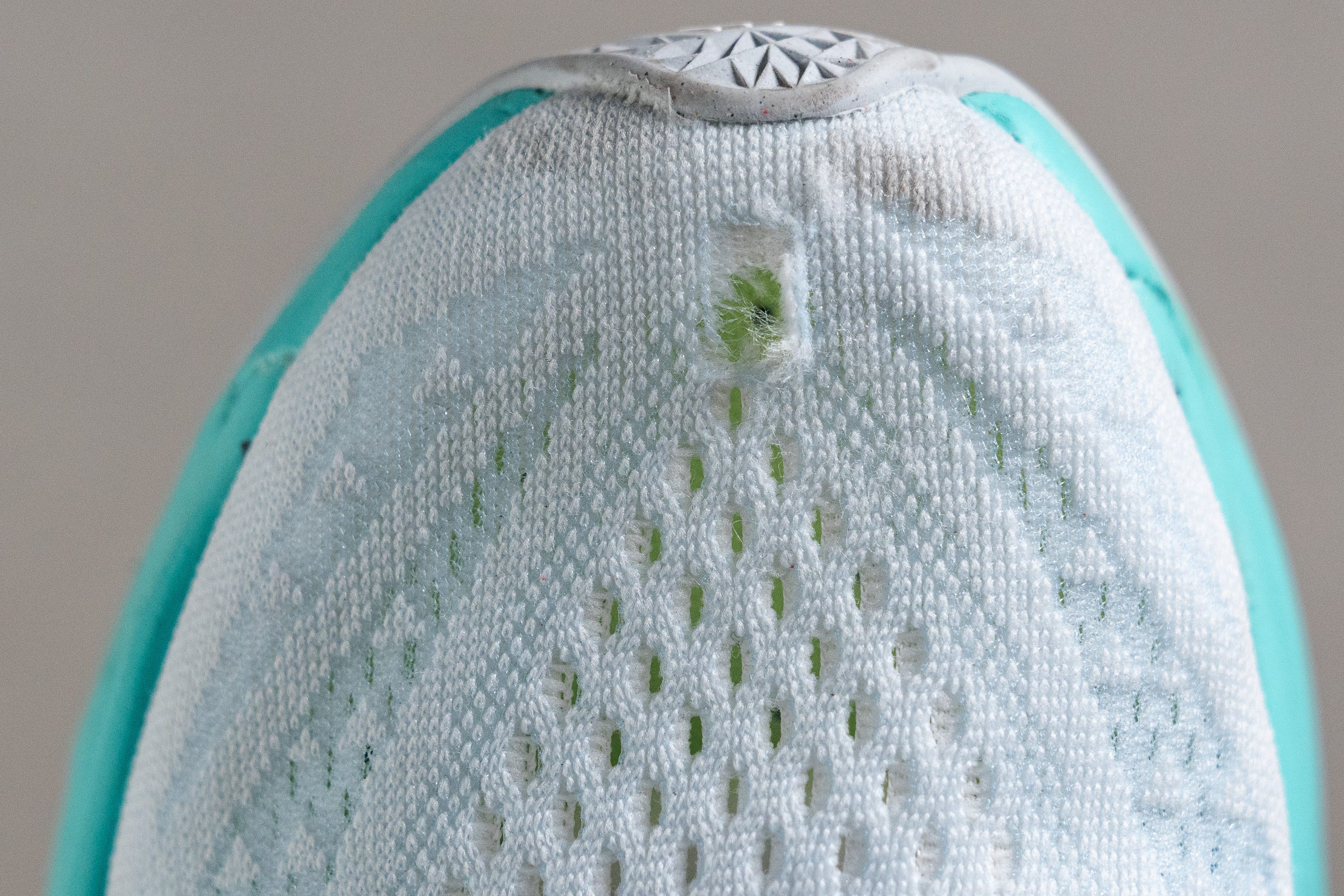
| FuelCell SuperComp Trainer v3 | 1 |
| Average | 2.6 |
Heel padding durability
After an initial setback with the SC Trainer v3, we shifted our focus to testing the heel padding—an area that typically raises concerns regarding wear and tear.
Fortunately, the results here were dramatically better. We were thrilled to award a 4/5 after evaluating the resilience shown against our testing tools. This marked a significant improvement that positively impacted our overall assessment of the shoe's durability.
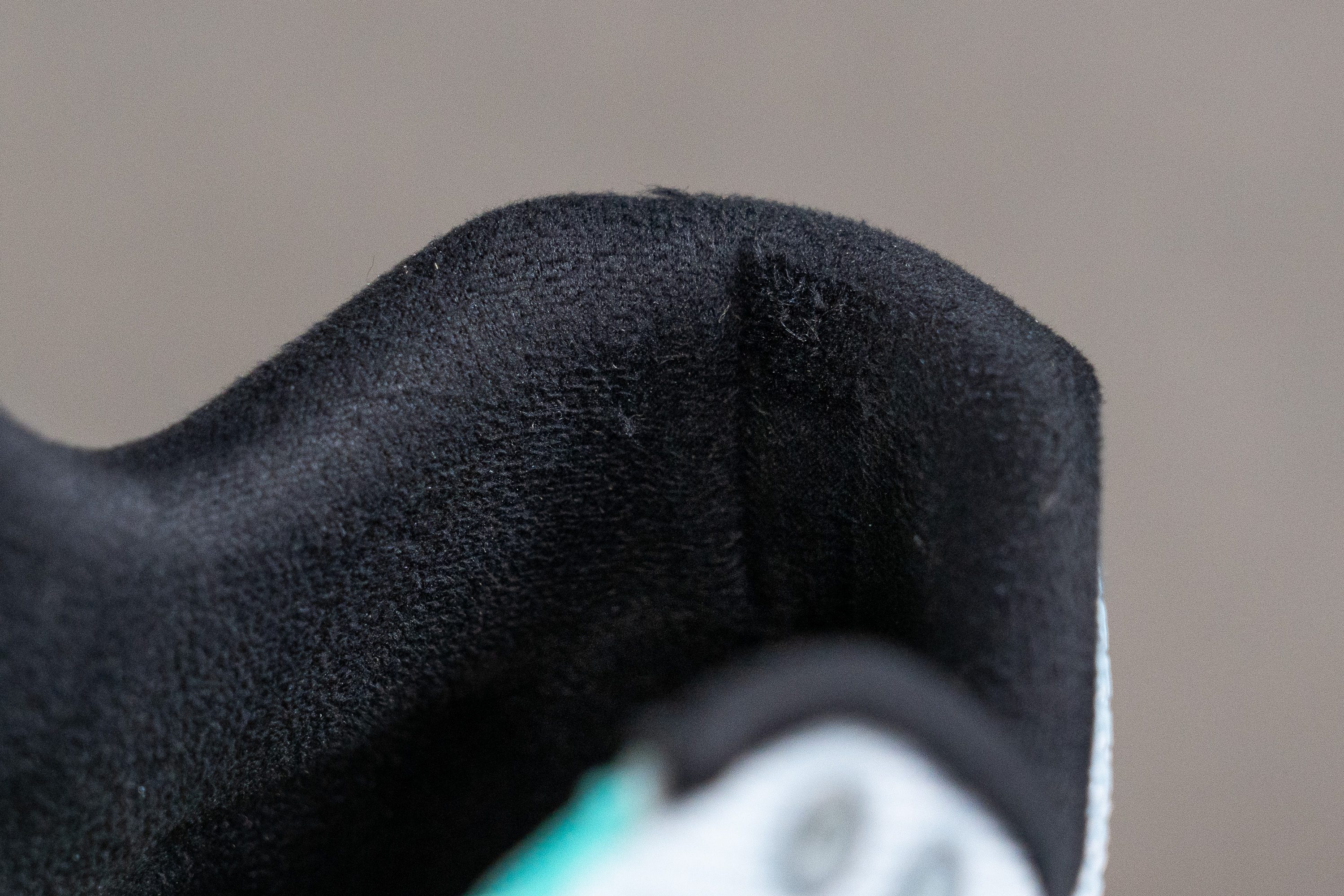
| FuelCell SuperComp Trainer v3 | 4 |
| Average | 3.4 |
Outsole durability
We conducted one final test using our Dremel. Despite the soft nature of this outsole, the resilience it displayed was decent. After our testing, we found only a 1.1 mm indentation, which is not bad for a 68.4-HC rubber.
For those seeking the best in both grip and durability, consider the impressive performance of the Adidas Adizero Prime X 2 Strung. However, be prepared for a higher price tag!
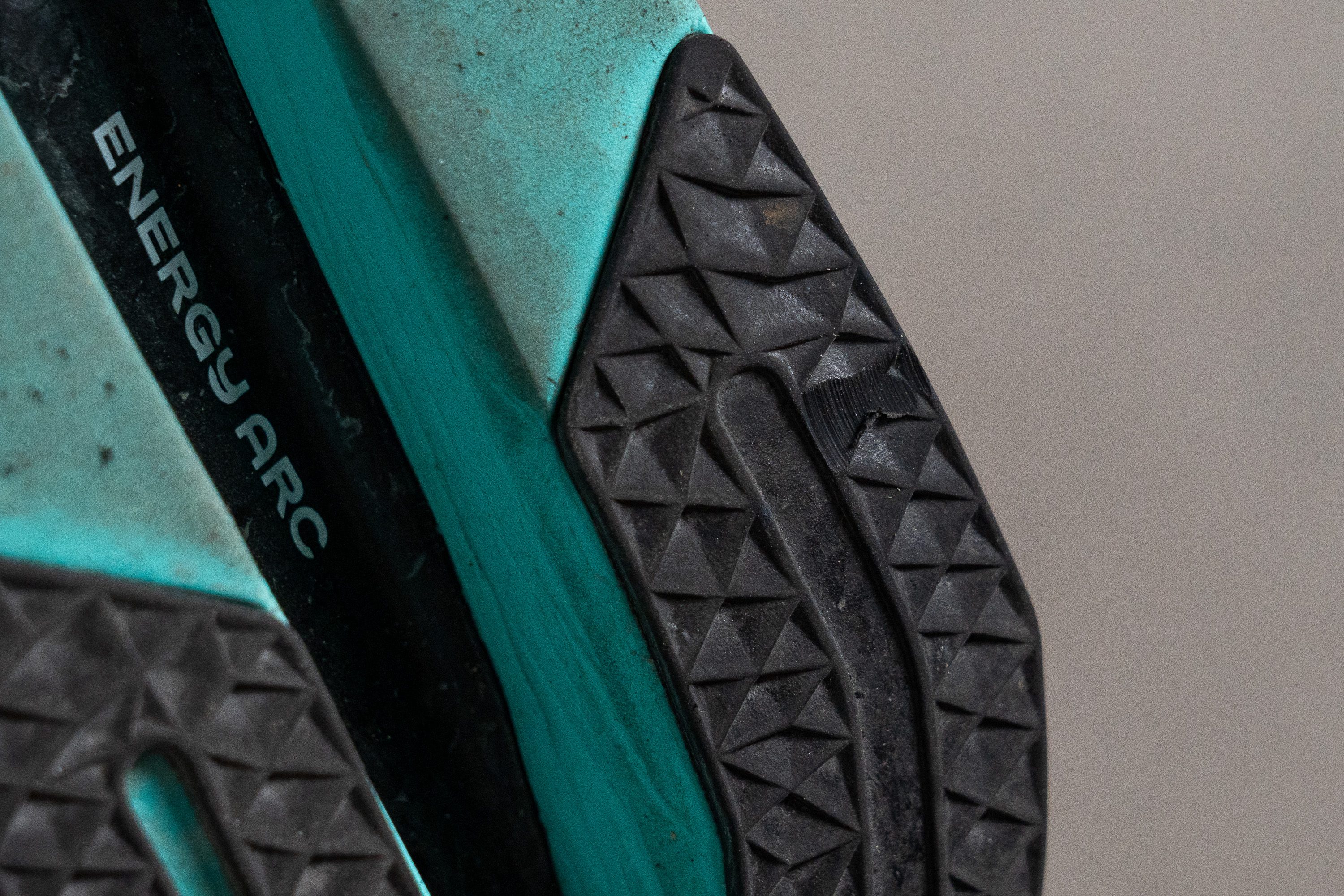
| FuelCell SuperComp Trainer v3 | 1.1 mm |
| Average | 1.1 mm |
Outsole thickness
We meticulously measure every aspect of running shoes, and the outsole thickness is crucial for assessing durability. We discovered a result of 3.0 mm, which provides ample material to withstand the usual wear and tear, based on our previous tests.
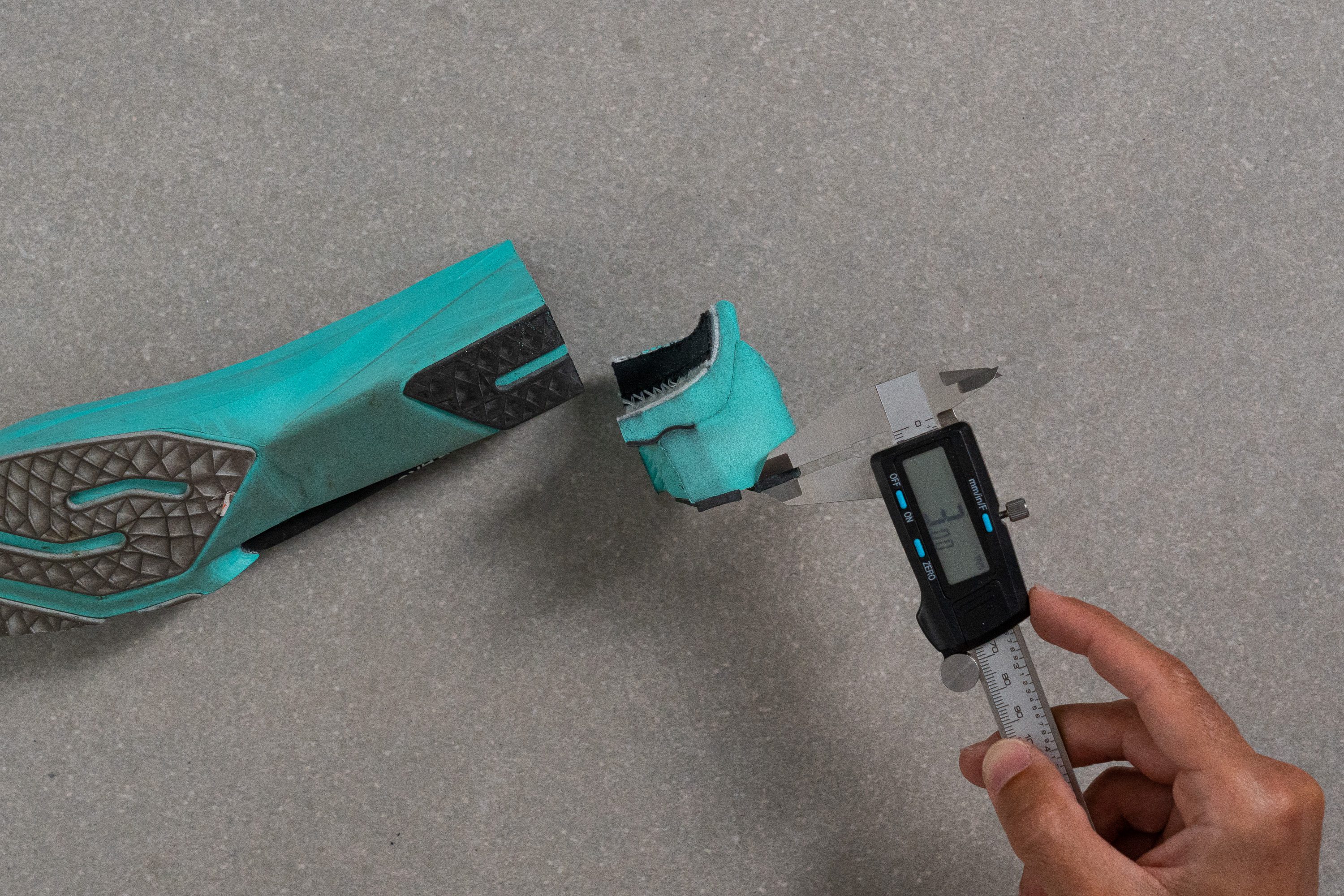
| FuelCell SuperComp Trainer v3 | 3.0 mm |
| Average | 3.2 mm |
Misc
Insole thickness
We measured the insole at a thin 2.9 mm—absolutely ideal for this type of high-performance trainer.
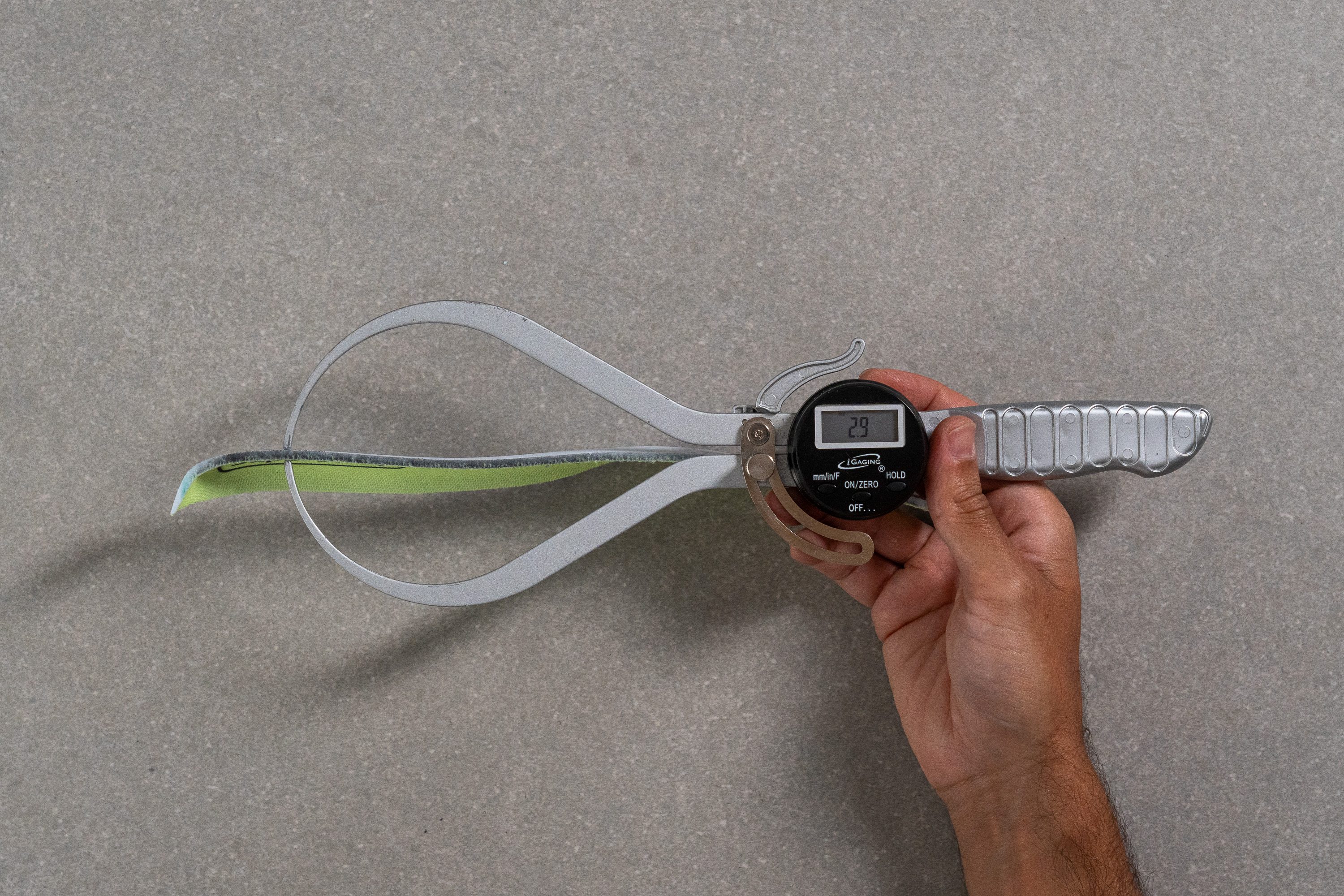
| FuelCell SuperComp Trainer v3 | 2.9 mm |
| Average | 4.5 mm |
Removable insole
The insole can be removed easily, but we advise against doing so unless absolutely necessary—it's a quality one, perforated and thin.
We also found that replacing it with a thicker insole could cause issues due to the shoe's low-volume toebox.
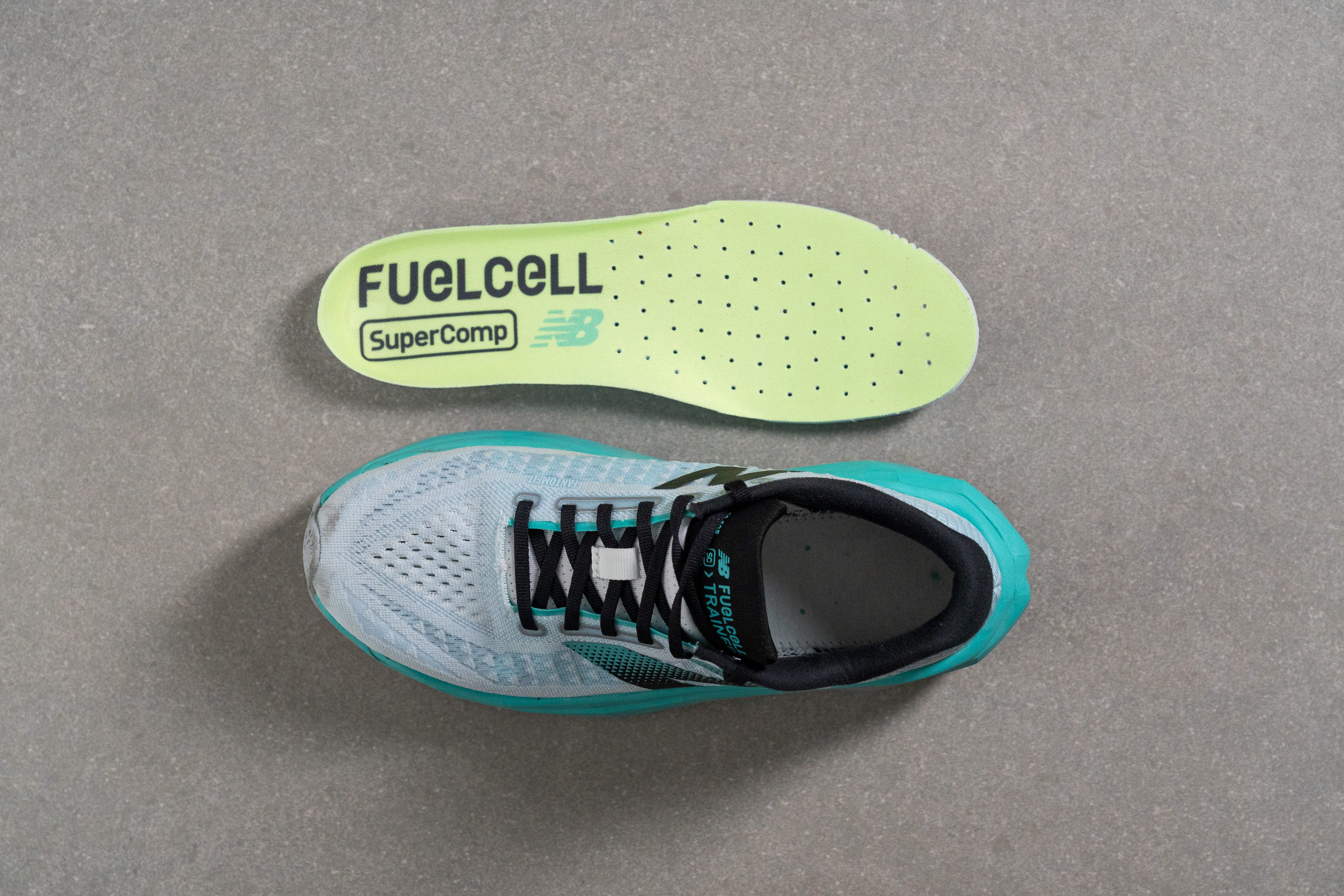
| FuelCell SuperComp Trainer v3 | Yes |
Midsole softness in cold (%)
We conducted a cold-weather test on the SC Trainer v3 by placing it in the freezer for 20 minutes before assessing its softness with a Shore A durometer. Interestingly, we found that it got 27.1% firmer. However, given the original buttery-soft nature of the FuelCell foam, it still registered an incredibly soft 11.1 HA!
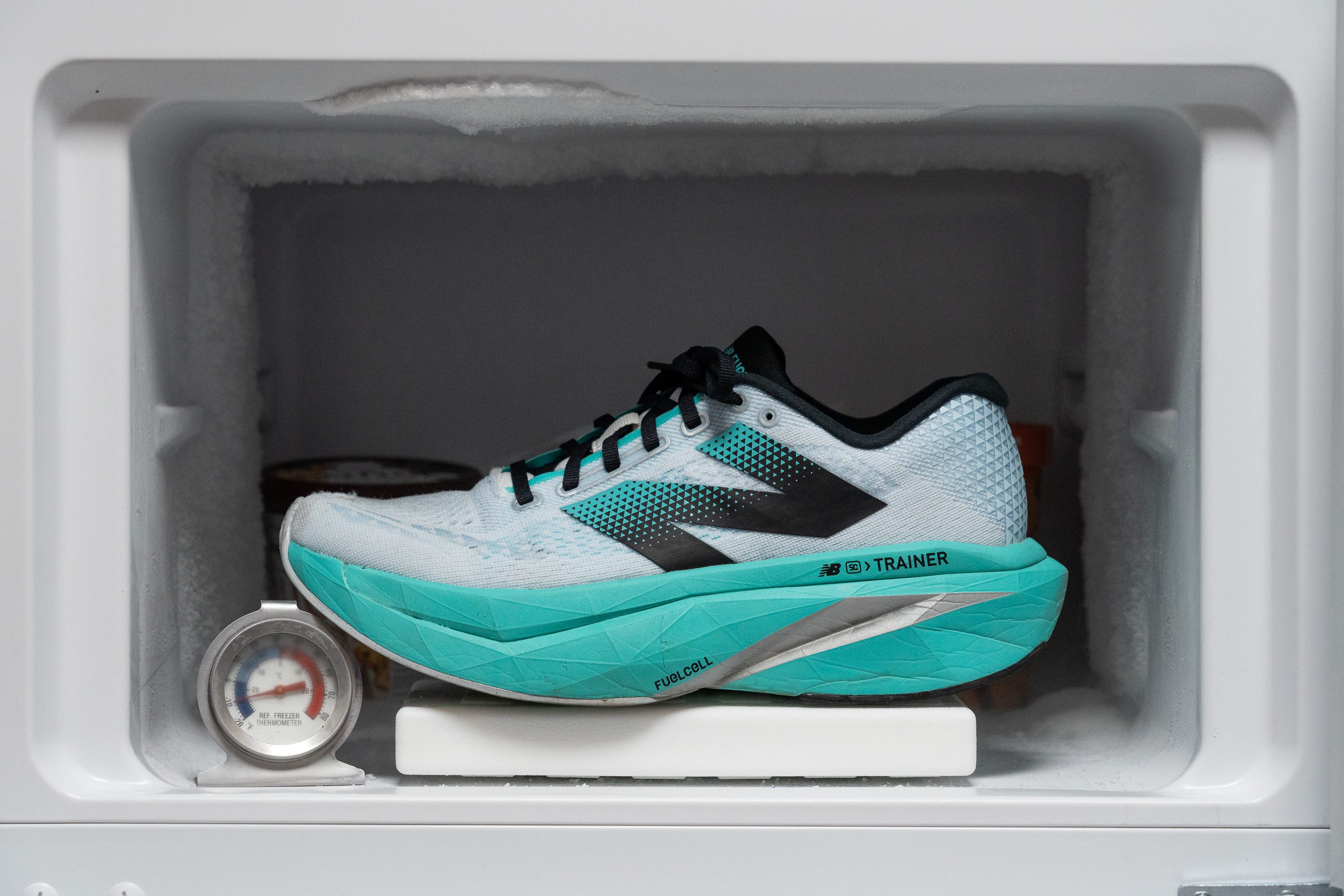
| FuelCell SuperComp Trainer v3 | 27% |
| Average | 24% |
Reflective elements
One downside the SC Trainer v3 inherits from its predecessors is not a welcome one—the absence of reflective elements. We would really appreciate enhanced nighttime visibility if New Balance introduces a version 4.

| FuelCell SuperComp Trainer v3 | No |
Tongue padding
The Trainer is designed as a long-distance uptempo companion, positioning it between a race shoe and a daily trainer in terms of speed. And the tongue strikes an ideal balance at 3.3 mm, offering both lightness and comfort—exactly what we expect for this kind of shoe.
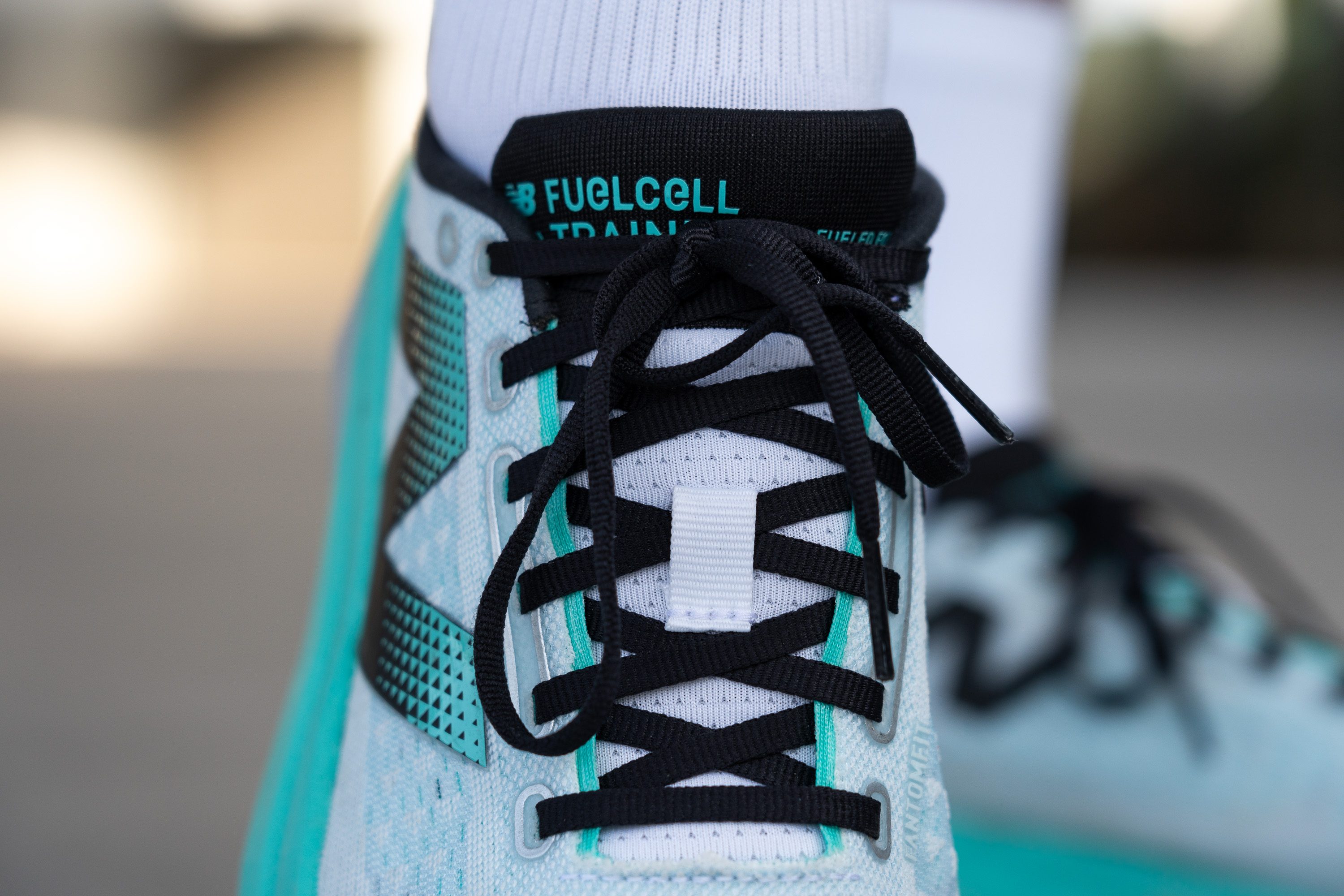
We also appreciated the tongue loop that helps keep the shoe securely in place. The overall lockdown is superb, as New Balance has opted for simple punched eyelets instead of a more complex lacing system, which is also our preferred setup.
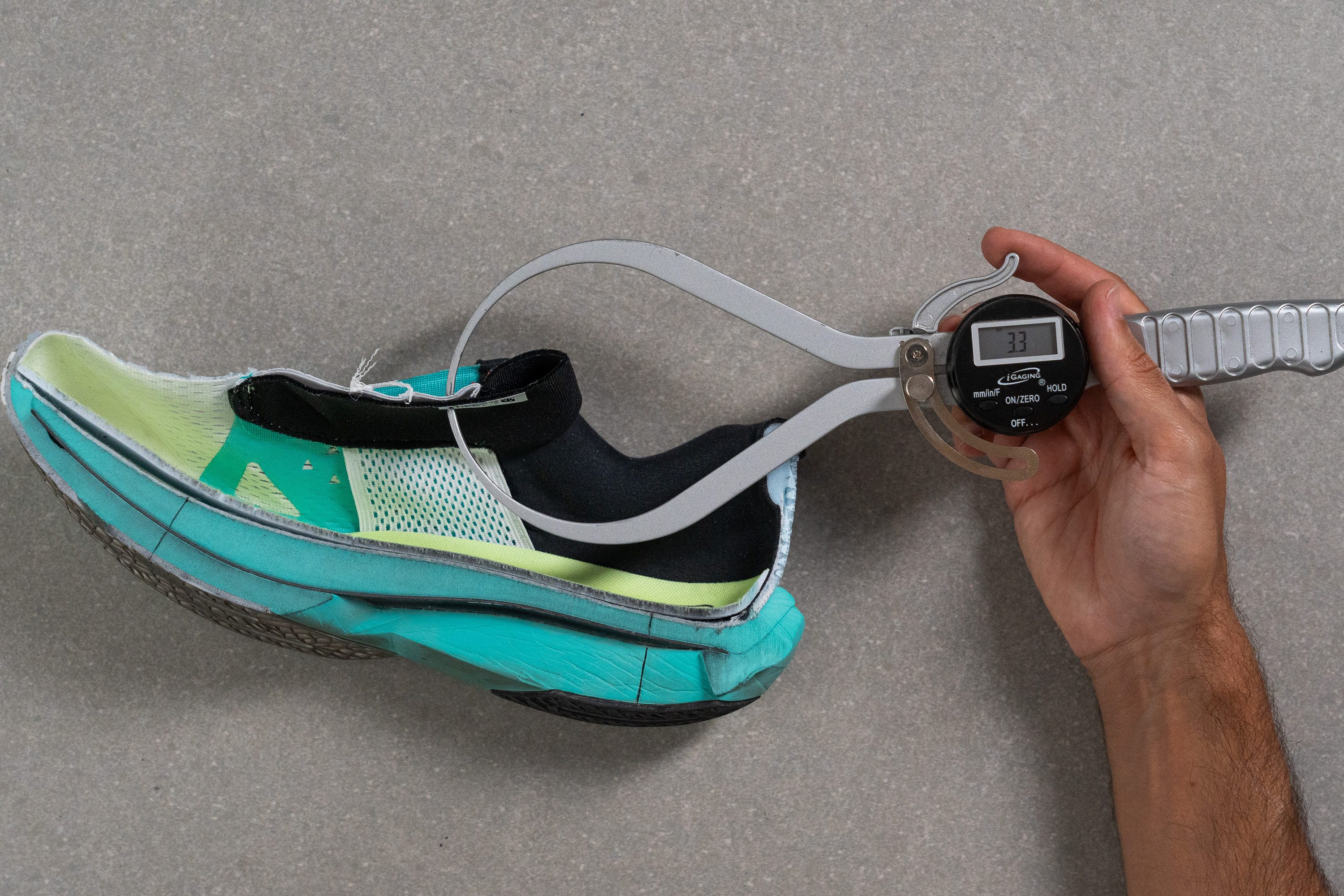
| FuelCell SuperComp Trainer v3 | 3.3 mm |
| Average | 5.8 mm |
Tongue: gusset type
Priced a bit under 200 US dollars, a non-gusseted tongue would have been a major disappointment. Luckily, we were pleased to discover that it's partially fixed to the sides, enhancing the fit particularly at faster paces. Nice!
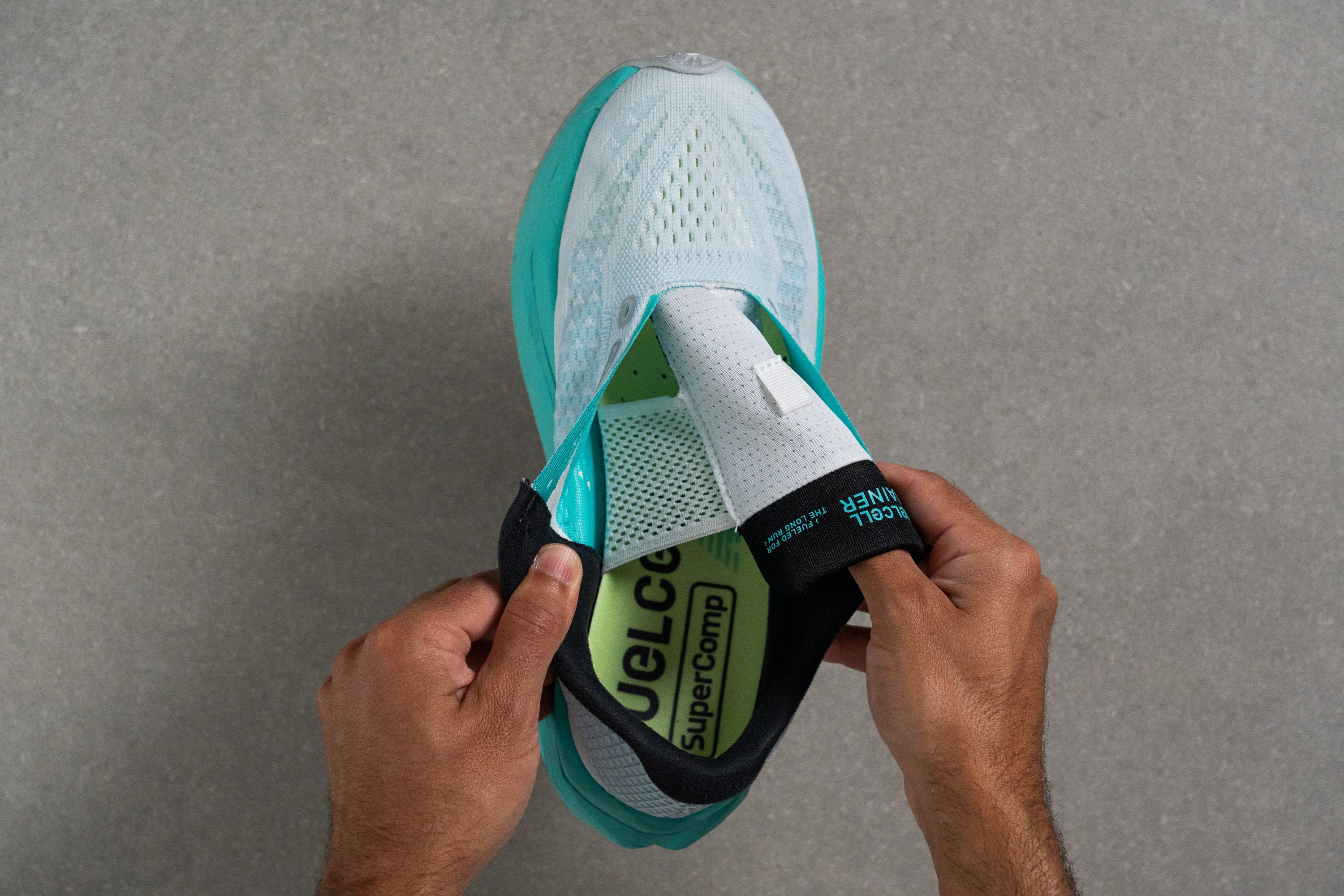
| FuelCell SuperComp Trainer v3 | Both sides (semi) |
Price
There are few carbon-plated running shoes on the market priced as competitively as the SC Trainer v3, leading us to conclude that New Balance has set a very fair price, at least in the US market.
However, NB often faces criticism in running forums for using less favorable exchange rates for currencies such as the Euro and the British Pound, which could make the price less attractive in other countries.
| FuelCell SuperComp Trainer v3 | $180 |
| Average | $152 |
Heel tab
This year, we're reviewing numerous New Balance road running shoes and have noted that all recent models lack a heel tab.
The SC Trainer v3 also features a tabless design but includes comfortable padding in the heel area—a detail we really appreciated. Although subtle, this padding is significant; the Rebel v4 had fit issues in the heel, and this addition addresses that concern.
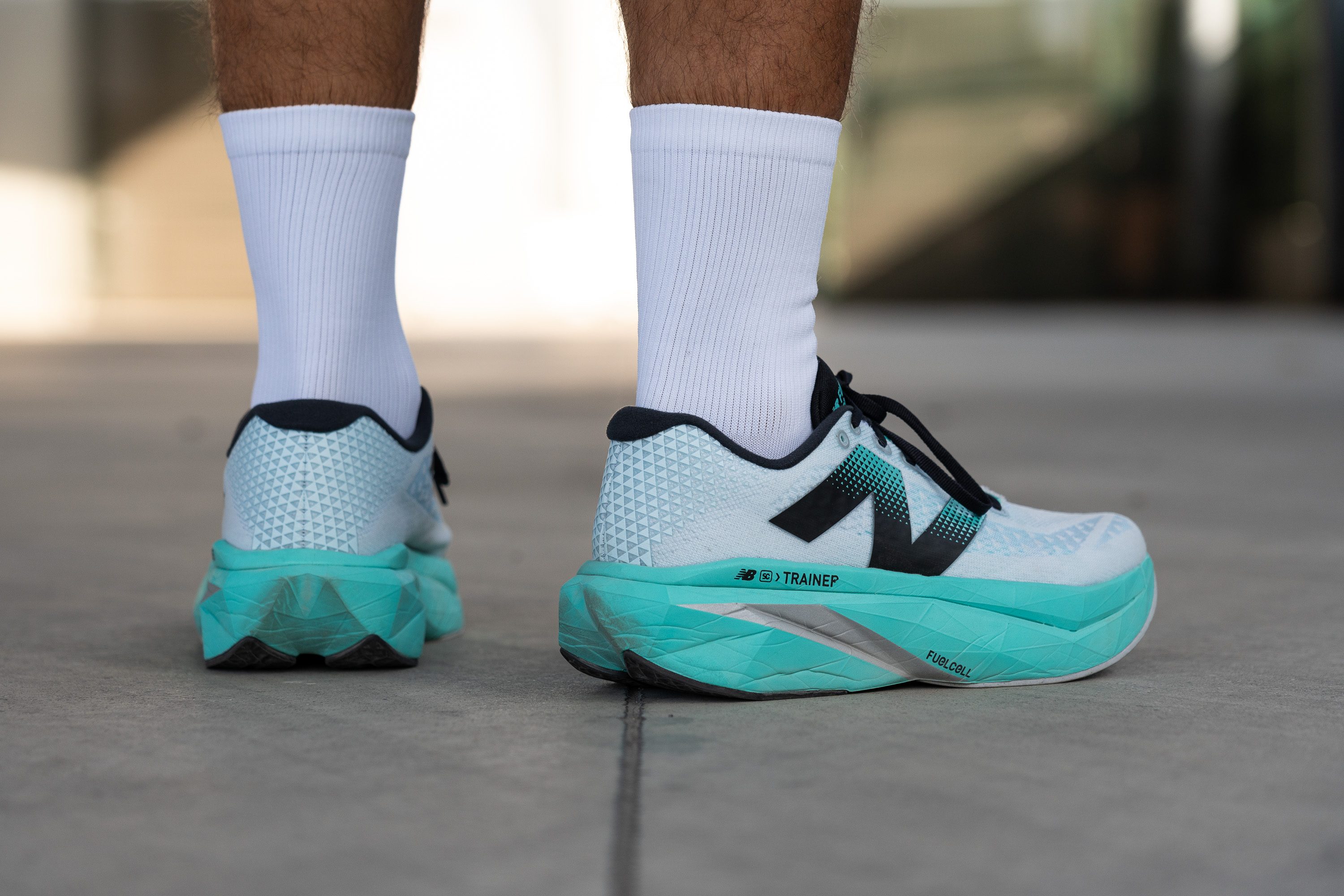
| FuelCell SuperComp Trainer v3 | None |

